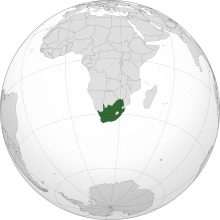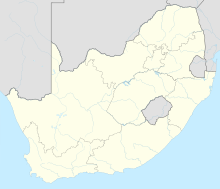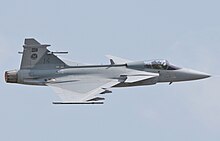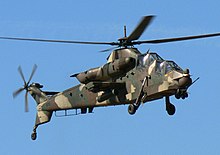South Africa
Republic of South Africa 11 other official languages[1]
| |||||||||||||||||||||
|---|---|---|---|---|---|---|---|---|---|---|---|---|---|---|---|---|---|---|---|---|---|
| Motto: "ǃke e: ǀxarra ǁke" (ǀXam) "Unity in diversity" | |||||||||||||||||||||
| Anthem: "National anthem of South Africa" | |||||||||||||||||||||
| Capital | |||||||||||||||||||||
| Largest city | Johannesburg[2] | ||||||||||||||||||||
| Official languages | 12 languages[4][5] Languages with special status[4] | ||||||||||||||||||||
| Ethnic groups (2022[6]) | |||||||||||||||||||||
| Religion (2022)[7] |
| ||||||||||||||||||||
| Demonym(s) | |||||||||||||||||||||
| Government | Unitary parliamentary republic with an executive presidency | ||||||||||||||||||||
| Cyril Ramaphosa | |||||||||||||||||||||
| Paul Mashatile | |||||||||||||||||||||
| Thoko Didiza | |||||||||||||||||||||
| Refilwe Mtsweni-Tsipane | |||||||||||||||||||||
| Mandisa Maya | |||||||||||||||||||||
| Legislature | Parliament | ||||||||||||||||||||
| National Council of Provinces | |||||||||||||||||||||
| National Assembly | |||||||||||||||||||||
| Independence from the United Kingdom | |||||||||||||||||||||
• Union | 31 May 1910 | ||||||||||||||||||||
| 11 December 1931 | |||||||||||||||||||||
• Republic | 31 May 1961 | ||||||||||||||||||||
| 4 February 1997 | |||||||||||||||||||||
| Area | |||||||||||||||||||||
• Total | 1,221,037 km2 (471,445 sq mi) (24th) | ||||||||||||||||||||
• Water (%) | 0.380 | ||||||||||||||||||||
| Population | |||||||||||||||||||||
• 2022 census | 62,027,503[8] (23rd) | ||||||||||||||||||||
• Density | 50.8/km2 (131.6/sq mi) (169th) | ||||||||||||||||||||
| GDP (PPP) | 2024 estimate | ||||||||||||||||||||
• Total | |||||||||||||||||||||
• Per capita | |||||||||||||||||||||
| GDP (nominal) | 2024 estimate | ||||||||||||||||||||
• Total | |||||||||||||||||||||
• Per capita | |||||||||||||||||||||
| Gini (2014) | very high inequality | ||||||||||||||||||||
| HDI (2022) | high (110th) | ||||||||||||||||||||
| Currency | South African rand (ZAR) | ||||||||||||||||||||
| Time zone | UTC+2 (SAST) | ||||||||||||||||||||
| Date format | Short formats: | ||||||||||||||||||||
| Drives on | Left | ||||||||||||||||||||
| Calling code | +27 | ||||||||||||||||||||
| ISO 3166 code | ZA | ||||||||||||||||||||
| Internet TLD | .za | ||||||||||||||||||||
South Africa, officially the Republic of South Africa (RSA), is the southernmost country in Africa. Its nine provinces are bounded to the south by 2,798 kilometres (1,739 miles) of coastline that stretches along the South Atlantic and Indian Ocean;[14][15][16] to the north by the neighbouring countries of Namibia, Botswana, and Zimbabwe; to the east and northeast by Mozambique and Eswatini; and it encloses Lesotho.[17] Covering an area of 1,221,037 square kilometres (471,445 square miles), the country has over 62 million people. Pretoria is the administrative capital, while Cape Town, as the seat of Parliament, is the legislative capital. Bloemfontein has traditionally been regarded as the judicial capital.[18] The largest and most populous city is Johannesburg, followed by Cape Town and the busiest port city in sub-Saharan Africa, Durban.
Archaeological findings suggest that various hominid species existed in South Africa about 2.5 million years ago, and modern humans inhabited the region over 100,000 years ago. The first known people were the indigenous Khoisan, and Bantu-speaking peoples who expanded from West and Central Africa later settled in the region 2,000 to 1,000 years ago. In the north, the Kingdom of Mapungubwe formed in the 13th century. In 1652, the Dutch established the first European settlement at Table Bay, and in 1795 and 1806, the British occupied it. The Mfecane, a period of significant upheaval, led to the formation of various African kingdoms, including the Zulu Kingdom. The region was further colonised, and diamonds and gold were discovered, bringing a shift towards industrialisation and urbanisation. The Union of South Africa was created in 1910 out of the former Cape, Natal, Transvaal, and Orange River colonies, becoming a republic in 1961. Though a system of non-racial franchise had existed in the Cape, it was gradually eroded, and the vast majority of Black South Africans were not enfranchised until 1994.
The National Party imposed apartheid in 1948, institutionalising previous racial segregation. After a largely non-violent struggle by the African National Congress and other anti-apartheid activists both inside and outside the country, the repeal of discriminatory laws began in the mid-1980s. Universal elections took place in 1994, following which all racial groups have held political representation in the country's liberal democracy, which comprises a parliamentary republic and nine provinces.
South Africa is a multi-ethnic society encompassing a variety of cultures, languages, and religions; it is often called the "rainbow nation" to describe its multicultural diversity, especially in the wake of apartheid.[19] Recognised as a middle power in international affairs, South Africa maintains significant regional influence and is a member of BRICS+, the African Union, SADC, SACU, the Commonwealth of Nations, and the G20.[20][21] A developing, newly industrialised country, South Africa has the largest economy in Africa by nominal GDP.[22][23] It is tied with Ethiopia for the most UNESCO World Heritage Sites in Africa,[24] and is a biodiversity hotspot with unique biomes, plant, and animal life. Since the end of apartheid, government accountability and quality of life have substantially improved.[25] However, crime, poverty, and inequality remain widespread.[26] Having the highest Gini coefficient of 0.63, South Africa is considered one of the most unequal countries in the world, if not the most unequal.[27][28]
Etymology
The name "South Africa" is derived from the country's geographic location at the southern tip of Africa. Upon formation, the country was named the Union of South Africa in English and Unie van Zuid-Afrika in Dutch, reflecting its origin from the unification of four British colonies. Since 1961, the long formal name in English has been the "Republic of South Africa" and Republiek van Suid-Afrika in Afrikaans. The country has an official name in 12 official languages.[29][30]
Mzansi, derived from the Xhosa noun uMzantsi meaning "south", is a colloquial name for South Africa,[31][32] while some Pan-Africanist political parties prefer the term "Azania".[33]
History
Prehistoric archaeology

South Africa contains some of the oldest archaeological and human-fossil sites in the world.[34][35][36] Archaeologists have recovered extensive fossil remains from a series of caves in Gauteng Province. The area, a UNESCO World Heritage Site, has been branded "the Cradle of Humankind". The sites include Sterkfontein, one of the richest sites for hominin fossils in the world, as well as Swartkrans, Gondolin Cave, Kromdraai, Cooper's Cave and Malapa. Raymond Dart identified the first hominin fossil discovered in Africa, the Taung Child (found near Taung) in 1924. Other hominin remains have come from the sites of Makapansgat in Limpopo Province; Cornelia and Florisbad in Free State Province; Border Cave in KwaZulu-Natal Province; Klasies River Caves in Eastern Cape Province; and Pinnacle Point, Elandsfontein and Die Kelders Cave in Western Cape Province.[37]
These finds suggest that various hominid species existed in South Africa from about three million years ago, starting with Australopithecus africanus,[38] followed by Australopithecus sediba, Homo ergaster, Homo erectus, Homo rhodesiensis, Homo helmei, Homo naledi and modern humans (Homo sapiens). Modern humans have inhabited Southern Africa for at least 170,000 years. Various researchers have located pebble tools within the Vaal River valley.[39][40]
Bantu expansion
Settlements of Bantu-speaking peoples, who were iron-using agriculturists and herdsmen, were present south of the Limpopo River (now the northern border with Botswana and Zimbabwe) by the 4th or 5th century AD. The Bantu slowly moved south. The earliest ironworks in modern-day KwaZulu-Natal Province are believed to date from around 1050. The southernmost group was the Xhosa people, whose language incorporates certain linguistic traits from the earlier Khoisan people. The Xhosa reached the Great Fish River, in today's Eastern Cape Province. As they migrated, these larger Iron Age populations displaced or assimilated earlier peoples. In Mpumalanga Province, several stone circles have been found along with a stone arrangement that has been named Adam's Calendar, and the ruins are thought to be created by the Bakone, a Northern Sotho people.[41][42]
Mapungubwe
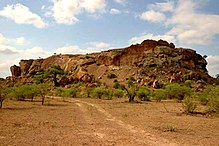
Around 1220, in the Limpopo-Shashe Basin, the elite of K2 moved to settle the flat-topped summit of Mapungubwe Hill, with the population settling below. Rainmaking was crucial to the development of sacral kingship. By 1250, the capital had a population of 5000 and the state covered 30,000 km² (11,500 square miles), growing wealthy through the Indian Ocean trade. The events around Mapungubwe's collapse circa 1300 are unknown, however trade routes shifted north from the Limpopo to the Zambezi, precipitating the rise of Great Zimbabwe. The hill was abandoned and Mapungubwe's population scattered.[43]
Portuguese exploration
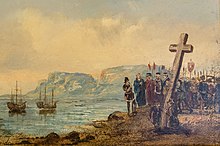
In 1487, the Portuguese explorer Bartolomeu Dias led the first European voyage to land in southern Africa.[44] On 4 December, he landed at Walfisch Bay (now known as Walvis Bay in present-day Namibia). This was south of the furthest point reached in 1485 by his predecessor, the Portuguese navigator Diogo Cão (Cape Cross, north of the bay). Dias continued down the western coast of southern Africa. After 8 January 1488, prevented by storms from proceeding along the coast, he sailed out of sight of land and passed the southernmost point of Africa without seeing it. He reached as far up the eastern coast of Africa as, what he called, Rio do Infante, probably the present-day Groot River, in May 1488. On his return he saw the cape, which he named Cabo das Tormentas ('Cape of Storms'). King John II renamed the point Cabo da Boa Esperança, or Cape of Good Hope, as it led to the riches of the East Indies.[45] Dias' feat of navigation was immortalised in Luís de Camões' 1572 epic poem Os Lusíadas.
Dutch colonisation

With Portugal's declining maritime power in the early 17th century, English and Dutch merchants competed to dislodge Portugal’s lucrative monopoly on the spice trade.[46] British East India Company representatives sporadically called at the cape in search of provisions as early as 1601 but later came to favour Ascension Island and Saint Helena as ports of refuge.[47] Dutch interest was aroused after 1647, when two employees of the Dutch East India Company were shipwrecked at the cape for several months. The sailors were able to survive by obtaining fresh water and meat from the natives.[47] They also sowed vegetables in the fertile soil.[48] Upon their return to Holland, they reported favourably on the cape's potential as a "warehouse and garden" for provisions to stock passing ships for long voyages.[47]
In 1652, a century and a half after the discovery of the cape sea route, Jan van Riebeeck established a victualling station at the Cape of Good Hope, at what would become Cape Town, on behalf of the Dutch East India Company.[49][50] In time, the cape became home to a large population of vrijlieden, also known as vrijburgers (lit. 'free citizens'), former company employees who stayed in Dutch overseas territories after serving their contracts.[50] Dutch traders also brought thousands of enslaved people to the fledgling colony from present-day Indonesia, Madagascar, and eastern Africa.[51] Some of the earliest mixed race communities in the country were formed between vrijburgers, enslaved people, and indigenous peoples.[52] This led to the development of a new ethnic group, the Cape Coloureds, most of whom adopted the Dutch language and Christian faith.[52]
Conflicts over resources between South Africa’s indigenous Khoisan people and Dutch settlers began in the 17th century and continued for centuries.[53]
Dutch colonists’ eastward expansion caused wars with the southwesterly migrating Xhosa tribe, known as the Xhosa Wars, as both sides competed for the pastureland near the Great Fish River, which the colonists desired for grazing cattle.[54] Vrijburgers who became independent farmers on the frontier were known as Boers, with some adopting semi-nomadic lifestyles being denoted as trekboers.[54] The Boers formed loose militias, which they termed commandos, and forged alliances with Khoisan peoples to repel Xhosa raids.[54] Both sides launched bloody but inconclusive offensives, and sporadic violence, often accompanied by livestock theft, remained common for several decades.[54]
British colonisation, the Mfecane, and the Great Trek
Great Britain occupied Cape Town between 1795 and 1803 to prevent it from falling under the control of the French First Republic, which had invaded the Low Countries.[54] After briefly returning to Dutch rule under the Batavian Republic in 1803, the cape was occupied again by the British in 1806.[55] Following the end of the Napoleonic Wars, it was formally ceded to Great Britain and became an integral part of the British Empire.[56] British emigration to South Africa began around 1818, subsequently culminating in the arrival of the 1820 Settlers.[56] The new colonists were induced to settle for a variety of reasons, namely to increase the size of the European workforce and to bolster frontier regions against Xhosa incursions.[56]

In the early 1800s, the Mfecane (lit. 'crushing') saw a heightened period of conflict, migration, and state formation among native groups, caused by the complex interplay of international trade, environmental instability, and European colonisation.[57] Chiefdoms grew wealthier and competed over trade routes and grazing land, leading to the formation of the Ndwandwe and Mthethwa Paramountcies in the east.[58] Ndwandwe defeated Mthethwa which split into different groups, one of which was led by Shaka of the amaZulu.[59] The 1810s saw the fourth and fifth Xhosa Wars as British colonisation expanded.[60] Ndwandwe splintered amid costly raids and Shaka's Zulu Kingdom rose to fill the power vacuum.[59] The Gaza kingdom formed. The Zulu totally defeated the Ndwandwe, however were repelled by Gaza.[61][62]
During the early 19th century, many Dutch settlers departed from the Cape Colony, where they had been subjected to British control, in a series of migrant groups who came to be known as Voortrekkers, meaning "pathfinders" or "pioneers". They migrated to the future Natal, Free State, and Transvaal regions. The Boers founded the Boer republics: the South African Republic, the Natalia Republic, and the Orange Free State.[63] In the interior, the Cape Colony expanded at the expense of the Batswana and Griqua, and Boer expansion caused great instability in the Middle Orange River region.[64] The Matabele kingdom came to dominate the eastern interior, and raided the Venda kingdom.[65]
The discovery of diamonds in 1867 and gold in 1884 in the interior started the Mineral Revolution and increased economic growth and immigration. This intensified British subjugation of the indigenous people. The struggle to control these important economic resources was a factor in relations between Europeans and the indigenous population and also between the Boers and the British.[66]

On 16 May 1876, President Thomas François Burgers of the South African Republic declared war against the Pedi people. King Sekhukhune managed to defeat the army on 1 August 1876. Another attack by the Lydenburg Volunteer Corps was also repulsed. On 16 February 1877, the two parties signed a peace treaty at Botshabelo.[67] The Boers' inability to subdue the Pedi led to the departure of Burgers in favour of Paul Kruger and the British annexation of the South African Republic. In 1878 and 1879 three British attacks were successfully repelled until Garnet Wolseley defeated Sekhukhune in November 1879 with an army of 2,000 British soldiers, Boers and 10,000 Swazis.
The Anglo-Zulu War was fought in 1879 between the British and the Zulu Kingdom. Following Lord Carnarvon's successful introduction of federation in Canada, it was thought that similar political effort, coupled with military campaigns, might succeed with the African kingdoms, tribal areas and Boer republics in South Africa. In 1874, Henry Bartle Frere was sent to South Africa as the British High Commissioner to bring such plans into being. Among the obstacles were the presence of the independent states of the Boers, and the Zululand army. The Zulu nation defeated the British at the Battle of Isandlwana. Eventually Zululand lost the war, resulting in the termination of the Zulu nation's independence.[68]
Boer Wars


The Boer republics successfully resisted British encroachments during the First Boer War (1880–1881) using guerrilla warfare tactics, which were well-suited to local conditions. The British returned with greater numbers, more experience, and new strategy in the Second Boer War (1899–1902) and, although suffering heavy casualties due to Boer attrition warfare, they were ultimately successful due in part to scorched earth tactics and concentration camps, in which 27,000 Boer civilians died due to a combination of disease and neglect.[69]
South Africa's urban population grew rapidly from the end of the 19th century onward. After the devastation of the wars, Boer farmers fled into Transvaal and Orange Free State cities and constituted a white urban poor class.[70]
Independence
Anti-British policies among white South Africans focused on independence. During the Dutch and British colonial years, racial segregation was mostly informal, though some legislation was enacted to control the settlement and movement of indigenous people, including the Native Location Act of 1879 and the system of pass laws.[71][72][73][74][75]
Eight years after the end of the Second Boer War and after four years of negotiation, the South Africa Act 1909 granted nominal independence while creating the Union of South Africa on 31 May 1910. The union was a dominion that included the former territories of the Cape, Transvaal and Natal colonies, as well as the Orange Free State republic.[76] The Natives' Land Act of 1913 severely restricted the ownership of land by blacks; at that stage they controlled only 7% of the country. The amount of land reserved for indigenous peoples was later marginally increased.[77]
In 1931, the union became fully sovereign from the United Kingdom with the passage of the Statute of Westminster, which abolished the last powers of the Parliament of the United Kingdom to legislate in the country. Only three other African countries—Liberia, Ethiopia, and Egypt—had been independent prior to that point. In 1934, the South African Party and National Party merged to form the United Party, seeking reconciliation between Afrikaners and English-speaking whites. In 1939, the party split over the entry of the union into World War II, as an ally of the United Kingdom, a move which National Party followers opposed.[78]
Apartheid era

In 1948, the National Party was elected to power. It strengthened the racial segregation begun under Dutch and British colonial rule. Taking Canada's Indian Act as a framework,[79] the nationalist government classified all peoples into three races (Whites, Blacks, Indians and Coloured people (people of mixed race)) and developed rights and limitations for each. The white minority (less than 20%)[80] controlled the vastly larger black majority. The legally institutionalised segregation became known as apartheid. While whites enjoyed the highest standard of living in all of Africa, comparable to First World Western nations, the black majority remained disadvantaged by almost every standard, including income, education, housing, and life expectancy.[81] The Freedom Charter, adopted in 1955 by the Congress Alliance, demanded a non-racial society and an end to discrimination.
On 31 May 1961, the country became a republic following a referendum (only open to white voters) which narrowly passed;[82] the British-dominated Natal province largely voted against the proposal. Elizabeth II lost the title Queen of South Africa, and the last Governor-General, Charles Robberts Swart, became state president. As a concession to the Westminster system, the appointment of the president remained by parliament and was virtually powerless until P. W. Botha's Constitution Act of 1983, which eliminated the office of prime minister and instated a unique "strong presidency" responsible to parliament. Pressured by other Commonwealth of Nations countries, South Africa withdrew from the organisation in 1961 and rejoined it in 1994.
Despite opposition to apartheid both within and outside the country, the government legislated for a continuation of apartheid. The security forces cracked down on internal dissent, and violence became widespread, with anti-apartheid organisations such as the African National Congress (ANC), the Azanian People's Organisation, and the Pan-Africanist Congress carrying out guerrilla warfare[83] and urban sabotage.[84] The three rival resistance movements also engaged in occasional inter-factional clashes as they jockeyed for domestic influence.[85] Apartheid became increasingly controversial, and several countries began to boycott business with the South African government because of its racial policies. The boycotts and restrictions were later extended to international sanctions and the divestment of holdings by foreign investors.[86][87]
Post-apartheid
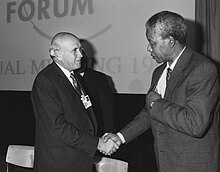
The Mahlabatini Declaration of Faith, signed by Mangosuthu Buthelezi and Harry Schwarz in 1974, enshrined the principles of peaceful transition of power and equality for all, the first of such agreements by black and white political leaders in South Africa. Ultimately, F.W. de Klerk opened bilateral discussions with Nelson Mandela in 1993 for a transition of policies and government.
In 1990, the National Party government took the first step towards dismantling discrimination when it lifted the ban on the ANC and other political organisations. It released Nelson Mandela from prison after 27 years of serving a sentence for sabotage. A negotiation process followed. With approval from the white electorate in a 1992 referendum, the government continued negotiations to end apartheid. South Africa held its first universal elections in 1994, which the ANC won by an overwhelming majority. It has been in power ever since. The country rejoined the Commonwealth of Nations and became a member of the Southern African Development Community.[88]
In post-apartheid South Africa, unemployment remained high. While many black people have risen to middle or upper classes, the overall unemployment rate of black people worsened between 1994 and 2003 by official metrics but declined significantly using expanded definitions.[89] Poverty among white South Africans, which was previously rare, increased.[90] The government struggled to achieve the monetary and fiscal discipline to ensure both redistribution of wealth and economic growth. The United Nations Human Development Index rose steadily until the mid-1990s[91] then fell from 1995 to 2005 before recovering its 1995 peak in 2013.[92] The fall is in large part attributable to the South African HIV/AIDS pandemic which saw South African life expectancy fall from a high point of 62 years in 1992 to a low of 53 in 2005,[93] and the failure of the government to take steps to address the pandemic in its early years.[94]
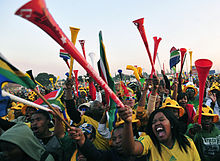

In May 2008, riots left over 60 people dead.[95] The Centre on Housing Rights and Evictions estimated that over 100,000 people were driven from their homes.[96] The targets were mainly legal and illegal migrants, and refugees seeking asylum, but a third of the victims were South African citizens.[95] In a 2006 survey, the South African Migration Project concluded that South Africans are more opposed to immigration than any other national group.[97] The UN High Commissioner for Refugees in 2008 reported that over 200,000 refugees applied for asylum in South Africa, almost four times as many as the year before.[98] These people were mainly from Zimbabwe, though many also come from Burundi, Democratic Republic of the Congo, Rwanda, Eritrea, Ethiopia and Somalia.[98] Competition over jobs, business opportunities, public services and housing has led to tension between refugees and host communities.[98] While xenophobia in South Africa is still a problem, the United Nations High Commissioner for Refugees in 2011 reported that recent violence had not been as widespread as initially feared.[98] Nevertheless, as South Africa continues to grapple with racial issues, one of the proposed solutions has been to pass legislation, such as the pending Hate Crimes and Hate Speech Bill, to uphold South Africa's ban on racism and commitment to equality.[99][100]
On 14 February 2018, Jacob Zuma resigned the presidency. Since 15 February, ANC president Cyril Ramaphosa has been President of South Africa. On 16 March 2018, just over a month after President Jacob Zuma resigned from the presidency, National Director of Public Prosecutions Shaun Abrahams announced that Zuma would again face prosecution on 16 criminal charges – 12 charges of fraud, two of corruption, and one each of racketeering and money laundering, just as in the 2006 indictment. A warrant was issued for his arrest in February 2020 after he failed to appear in court. In 2021 he was found guilty of contempt of court and sentenced to 15 months' imprisonment. In response, supporters of Zuma engaged in protests which led to riots, looting, vandalism and widespread violence, leaving 354 people dead.[101]
South Africa has been undergoing a period of intense political and economic crisis since 2020 with growing numbers of international institutions, businesses and political figures warning that the country risks collapsing into a failed state due to high unemployment, low economic growth, low business investment, rising levels of violent crime, disorder, political corruption, and state capture.[102][103][104][105][106] The country has been undergoing an energy crisis since 2007, resulting in routine rolling electricity blackouts due to loadshedding.[107] According to the International Monetary Fund, South Africa is suffering from "massive corruption" and state capture.[108]
The Zondo Commission, established in 2018 in order to investigate allegations of corruption and state capture released its findings in 2022. It found rampant corruption at every level of government, including Transnet, Eskom, and Denel, as well as law enforcement, intelligence agencies, and the civil service. It documented evidence of systemic corruption, fraud, racketeering, bribery, money laundering, and state capture. It investigated the African National Congress party and Jacob Zuma, whom it concluded were complicit in state capture through their direct assistance to the Gupta family.[109][110] "The Commission estimated the total amount of money spent by the state which was 'tainted' by state capture to be around R57 billion. More than 97% of the R57 billion came from Transnet and Eskom. Out of these funds, the Gupta enterprise received at least R15 billion. The total loss to the state is difficult to quantify, but would far exceed that R15 billion."[110]
South Africa has maintained a position of neutrality in regards to the Russia invasion of Ukraine in 2022 and the ongoing war. On 29 December 2023, South Africa formally submitted its case to the International Court of Justice regarding Israel's conduct in the Gaza Strip as part of the Israel–Hamas war, alleging that Israel had committed and was committing genocide against Palestinians in the Gaza Strip. South Africa has repeatedly hosted senior leaders of Hamas, the group responsible for the October 7th massacre in Israel.[111][112]
Following the 2024 general elections, the African National Congress saw its share of the national vote fall below 50% for the first time since the end of Apartheid, though it remained the single largest party in the South African Parliament.[113] President Ramaphosa announced a national unity government, the first since the Cabinet of Nelson Mandela, and entered a deal with the Democratic Alliance, the previous main opposition party, and other minor parties.[114] Ramaphosa was reelected for a second term in office by the National Assembly against the leader of the Economic Freedom Fighters, Julius Malema.[115]
Geography

South Africa is in southernmost Africa, with a coastline that stretches more than 2,500 km (1,553 mi) and along two oceans (the South Atlantic and the Indian). At 1,219,912 km2 (471,011 sq mi),[116] South Africa is the 24th-largest country in the world.[117] Excluding the Prince Edward Islands, the country lies between latitudes 22° and 35°S, and longitudes 16° and 33°E. The interior of South Africa consists of a large, in most places almost flat plateau with an altitude of between 1,000 m (3,300 ft) and 2,100 m (6,900 ft), highest in the east and sloping gently downwards towards the west and north, and slightly so to the south and south-west.[118] This plateau is surrounded by the Great Escarpment[119] whose eastern, and highest, stretch is known as the Drakensberg.[120] Mafadi in the Drakensberg at 3,450 m (11,320 ft) is the highest peak. The KwaZulu-Natal–Lesotho international border is formed by the highest portion of the Great Escarpment which reaches an altitude of over 3,000 m (9,800 ft).[121]
The south and south-western parts of the plateau (at approximately 1,100–1,800 m above sea level) and the adjoining plain below (at approximately 700–800 m above sea level – see map on the right) is known as the Great Karoo, which consists of sparsely populated shrubland. To the north, the Great Karoo fades into the more arid Bushmanland, which eventually becomes the Kalahari Desert in the north-west of the country. The mid-eastern and highest part of the plateau is known as the Highveld. This relatively well-watered area is home to a great proportion of the country's commercial farmlands and contains its largest conurbation (Gauteng). To the north of Highveld, from about the 25° 30' S line of latitude, the plateau slopes downwards into the Bushveld, which ultimately gives way to the Limpopo River lowlands or Lowveld.[119]
The coastal belt, below the Great Escarpment, moving clockwise from the northeast, consists of the Limpopo Lowveld, which merges into the Mpumalanga Lowveld, below the Mpumalanga Drakensberg (the eastern portion of the Great Escarpment).[122] This is hotter, drier and less intensely cultivated than the Highveld above the escarpment.[119] The Kruger National Park, located in the provinces of Limpopo and Mpumalanga in north-eastern South Africa, occupies a large portion of the Lowveld covering 19,633 square kilometres (7,580 sq mi)[123]
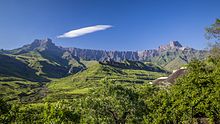

The coastal belt below the south and south-western stretches of the Great Escarpment contains several ranges of Cape Fold Mountains which run parallel to the coast, separating the Great Escarpment from the ocean.[124][125] (These parallel ranges of fold mountains are shown on the map, above left. Note the course of the Great Escarpment to the north of these mountain ranges.) The land between the Outeniqua and Langeberg ranges to the south and the Swartberg range to the north is known as the Little Karoo,[119] which consists of semi-desert shrubland similar to that of the Great Karoo, except that its northern strip along the foothills of the Swartberg Mountains has a somewhat higher rainfall and is, therefore, more cultivated than the Great Karoo. The Little Karoo is famous for its ostrich farming around Oudtshoorn. The lowland area to the north of the Swartberg range up to the Great Escarpment is the lowland part of the Great Karoo, which is climatically and botanically almost indistinguishable from the Karoo above the Great Escarpment. The narrow coastal strip between the Outeniqua and Langeberg ranges and the ocean has a moderately high year-round rainfall, which is known as the Garden Route. It is famous for the most extensive areas of forests in South Africa (a generally forest-poor country).
In the south-west corner of the country, the Cape Peninsula forms the southernmost tip of the coastal strip which borders the Atlantic Ocean and ultimately terminates at the country's border with Namibia at the Orange River. The Cape Peninsula has a Mediterranean climate, making it and its immediate surrounds the only portion of Sub-Saharan Africa which receives most of its rainfall in winter.[126][127] The coastal belt to the north of the Cape Peninsula is bounded on the west by the Atlantic Ocean and the first row of north–south running Cape Fold Mountains to the east. The Cape Fold Mountains peter out at about the 32° S line of latitude,[125] after which the Great Escarpment bounds the coastal plain. The most southerly portion of this coastal belt is known as the Swartland and Malmesbury Plain, which is an important wheat growing region, relying on winter rains. The region further north is known as Namaqualand,[128] which becomes more arid near the Orange River. The little rain that falls tends to fall in winter,[127] which results in one of the world's most spectacular displays of flowers carpeting huge stretches of veld in spring (August–September).
South Africa also has one offshore possession, the small sub-Antarctic archipelago of the Prince Edward Islands, consisting of Marion Island (290 km2 or 110 sq mi) and Prince Edward Island (45 km2 or 17 sq mi)
Climate

South Africa has a generally temperate climate because it is surrounded by the Atlantic and Indian Oceans on three sides, because it is located in the climatically milder Southern Hemisphere, and because its average elevation rises steadily toward the north (toward the equator) and further inland. This varied topography and oceanic influence result in a great variety of climatic zones. The climatic zones range from the extreme desert of the southern Namib in the farthest northwest to the lush subtropical climate in the east along the border with Mozambique and the Indian Ocean. Winters in South Africa occur between June and August. The extreme southwest has a climate similar to that of the Mediterranean with wet winters and hot, dry summers, hosting the famous fynbos biome of shrubland and thicket. This area produces much of the wine in South Africa and is known for its wind, which blows intermittently almost all year. The severity of this wind made passing around the Cape of Good Hope particularly treacherous for sailors, causing many shipwrecks. Further east on the south coast, rainfall is distributed more evenly throughout the year, producing a green landscape. The annual rainfall increases south of the Lowveld, especially near the coast, which is subtropical. The Free State is particularly flat because it lies centrally on the high plateau. North of the Vaal River, the Highveld becomes better watered and does not experience subtropical extremes of heat. Johannesburg, in the centre of the Highveld, is at 1,740 m (5,709 ft) above sea level and receives an annual rainfall of 760 mm (29.9 in). Winters in this region are cold, although snow is rare.[129]
The coldest place on mainland South Africa is Buffelsfontein in the Eastern Cape, where a temperature of −20.1 °C (−4.2 °F) was recorded in 2013.[130] The Prince Edward Islands have colder average annual temperatures, but Buffelsfontein has colder extremes. The deep interior of mainland South Africa has the hottest temperatures: a temperature of 51.7 °C (125.06 °F) was recorded in 1948 in the Northern Cape Kalahari near Upington,[131] but this temperature is unofficial and was not recorded with standard equipment; the official highest temperature is 48.8 °C (119.84 °F) at Vioolsdrif in January 1993.[132]
Climate change in South Africa is leading to increased temperatures and rainfall variability. Extreme weather events are becoming more prominent.[133] This is a critical concern for South Africans as climate change will affect the overall status and wellbeing of the country, for example with regards to water resources. Speedy environmental changes are resulting in clear effects on the community and environmental level in different ways and aspects, starting with air quality, to temperature and weather patterns, reaching out to food security and disease burden.[134] According to computer-generated climate modelling produced by the South African National Biodiversity Institute,[135] parts of southern Africa will see an increase in temperature by about 1 °C (1.8 °F) along the coast to more than 4 °C (7.2 °F) in the already hot hinterland such as the Northern Cape in late spring and summertime by 2050. The Cape Floral Region is predicted to be hit very hard by climate change. Drought, increased intensity and frequency of fire, and climbing temperatures are expected to push many rare species towards extinction. South Africa has published two national climate change reports in 2011 and 2016.[136] South Africa contributes considerable carbon dioxide emissions, being the 14th largest emitter of carbon dioxide,[137] primarily from its heavy reliance on coal and oil for energy production.[137] As part of its international commitments, South Africa has pledged to peak emissions between 2020 and 2025.[137]
Biodiversity


South Africa signed the Rio Convention on Biological Diversity on 4 June 1994 and became a party to the convention on 2 November 1995.[138] It has subsequently produced a National Biodiversity Strategy and Action Plan, which was received by the convention on 7 June 2006.[139] The country is ranked sixth out of the world's seventeen megadiverse countries.[140] Ecotourism in South Africa has become more prevalent in recent years, as a possible method of maintaining and improving biodiversity.
Numerous mammals are found in the Bushveld including lions, African leopards, South African cheetahs, southern white rhinos, blue wildebeest, kudus, impalas, hyenas, hippopotamuses and South African giraffes. A significant extent of the Bushveld exists in the north-east including Kruger National Park and the Sabi Sand Game Reserve, as well as in the far north in the Waterberg Biosphere. South Africa houses many endemic species, among them the critically endangered riverine rabbit (Bunolagus monticullaris) in the Karoo.
Up to 1945, more than 4,900 species of fungi (including lichen-forming species) had been recorded.[141] In 2006, the number of fungi in South Africa was estimated at 200,000 species but did not take into account fungi associated with insects.[142] If correct, then the number of South African fungi dwarfs that of its plants. In at least some major South African ecosystems, an exceptionally high percentage of fungi are highly specific in terms of the plants with which they occur.[143] The country's Biodiversity Strategy and Action Plan does not mention fungi (including lichen-forming fungi).[139]
With more than 22,000 different vascular plants, or about 9% of all the known species of plants on Earth,[144] South Africa is particularly rich in plant diversity. The most prevalent biome is the grassland, particularly on the Highveld, where the plant cover is dominated by different grasses, low shrubs, and acacia, mainly camel-thorn (Vachellia erioloba). Vegetation is sparse towards the north-west because of low rainfall. There are numerous species of water-storing succulents, like aloes and euphorbias, in the very hot and dry Namaqualand area. And according to the World Wildlife Fund, South Africa is home to around a third of all succulent species.[145] The grass and thorn savanna turns slowly into a bush savanna towards the north-east of the country, with denser growth. There are significant numbers of baobab trees in this area, near the northern end of Kruger National Park.[146]
The fynbos biome, which makes up the majority of the area and plant life in the Cape Floristic Region, is located in a small region of the Western Cape and contains more than 9,000 of those species, or three times more plant species than found in the Amazon rainforest,[147] making it among the richest regions on earth in terms of plant diversity. Most of the plants are evergreen hard-leaf plants with fine, needle-like leaves, such as the sclerophyllous plants. Another uniquely South African flowering plant group is the genus Protea, with around 130 different species. While South Africa has a great wealth of flowering plants, only 1% of the land is forest, almost exclusively in the humid coastal plain of KwaZulu-Natal, where there are also areas of Southern Africa mangroves in river mouths. Even smaller reserves of forests are out of the reach of fire, known as montane forests. Plantations of imported tree species are predominant, particularly the non-native eucalyptus and pine.

South Africa has lost a large area of natural habitat in the last four decades, primarily because of overpopulation, sprawling development patterns, and deforestation during the 19th century. The country had a 2019 Forest Landscape Integrity Index mean score of 4.94/10, ranking it 112th globally out of 172 countries.[148] South Africa is one of the worst affected countries in the world when it comes to invasion by alien species with many (e.g., black wattle, Port Jackson willow, Hakea, Lantana and Jacaranda) posing a significant threat to the native biodiversity and the already scarce water resources. Also woody plant encroachment of native plants in grasslands poses a threat to biodiversity and related ecosystem services, affecting over 7 million hectares.[149] The original temperate forest found by the first European settlers was exploited until only small patches remained. Currently, South African hardwood trees like real yellowwood (Podocarpus latifolius), stinkwood (Ocotea bullata), and South African black ironwood (Olea capensis) are under strict government protection. Statistics from the Department of Environmental Affairs show a record 1,215 rhinos were killed in 2014.[150] Since South Africa is home to a third of all succulent species (many endemic to the Karoo), it makes it a hotspot for plant poaching, leading to many species to be threatened with extinction.[145]
Demographics

- <1 /km2
- 1–3 /km2
- 3–10 /km2
- 10–30 /km2
- 30–100 /km2
- 100–300 /km2
- 300–1000 /km2
- 1000–3000 /km2
- >3000 /km2
South Africa is a nation of about 62 million (as of 2022) people of diverse origins, cultures, languages, and religions.[151] The last census was held in 2022, with estimates produced on an annual basis. According to the United Nations' World Population Prospects, South Africa's total population was 55.3 million in 2015, compared to only 13.6 million in 1950.[152] South Africa is home to an estimated five million illegal immigrants, including some three million Zimbabweans.[153][154][155] A series of anti-immigrant riots occurred beginning in May 2008.[156][157]
Statistics South Africa asks people to describe themselves in the census in terms of five racial population groups.[158] The 2022 census figures for these groups were: Black African at 81%, Coloured at 8.2%, White at 7.3%, Indian or Asian at 2.7%, and Other/Unspecified at 0.5%.[8] The first census in 1911 showed that whites made up 22% of the population; this had declined to 16% by 1980.[159]
South Africa hosts a sizeable refugee and asylum seeker population. According to the World Refugee Survey 2008, published by the U.S. Committee for Refugees and Immigrants, this population numbered approximately 144,700 in 2007.[160] Groups of refugees and asylum seekers numbering over 10,000 included people from Zimbabwe (48,400), the DRC (24,800), and Somalia (12,900).[160] These populations mainly lived in Johannesburg, Pretoria, Durban, Cape Town, and Port Elizabeth.[160]
Languages
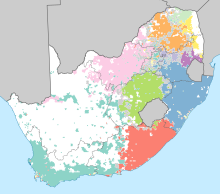
South Africa has 12 official languages:[5] Zulu, Xhosa, Afrikaans, English, Pedi,[161] Tswana, Southern Sotho, Tsonga, Swazi, Venda, and Southern Ndebele (in order of first language speakers), as well as South African Sign Language which was recognised as an official language in 2023.[5] In this regard it is fourth only to Bolivia, India, and Zimbabwe in number. While all the languages are formally equal, some languages are spoken more than others. According to the 2022 census, the three most spoken first languages are Zulu (24.4%), Xhosa (16.6%), and Afrikaans (10.6%).[8] Although English is recognised as the language of commerce and science, it is only the fifth most common home language, that of only 8.7% of South Africans in 2022; nevertheless, it has become the de facto lingua franca of the nation.[8] Estimates based on the 1991 census suggest just under half of South Africans could speak English.[162] It is the second most commonly spoken language outside of the household, after Zulu.[163]
Other languages are spoken, or were widely used previously, including Fanagalo, Khoe, Lobedu, Nama, Northern Ndebele, and Phuthi.[164] Many of the unofficial languages of the San and Khoekhoe peoples contain regional dialects stretching northwards into Namibia and Botswana, and elsewhere. These people, who are a physically distinct population from the Bantu people who make up most of the Black Africans in South Africa, have their own cultural identity based on their hunter-gatherer societies. They have been marginalised, and the remainder of their languages are in danger of becoming extinct.
White South Africans may also speak European languages, including Italian, Portuguese (also spoken by black Angolans and Mozambicans), Dutch, German, and Greek, while some Indian South Africans and more recent migrants from South Asia speak Indian languages, such as Gujarati, Hindi, Tamil, Telugu, and Urdu. French is spoken by migrants from Francophone Africa.
Religion
According to the 2001 census, Christians accounted for 79.8% of the population, with a majority of them being members of various Protestant denominations (broadly defined to include syncretic African-initiated churches) and a minority of Roman Catholics and other Christians. The Christian category includes Zion Christian (11.1%), Pentecostal (Charismatic) (8.2%), Roman Catholic (7.1%), Methodist (6.8%), Dutch Reformed (6.7%), and Anglican (3.8%). Members of the remaining Christian churches accounted for another 36% of the population. Muslims accounted for 1.5% of the population, Hindus 1.2%,[166] traditional African religions 0.3% and Judaism 0.2%. 15.1% had no religious affiliation, 0.6% were "other" and 1.4% were "unspecified."[167][166][168][169]
African-initiated churches formed the largest of the Christian groups. It was believed that many of the persons who claimed no affiliation with any organised religion adhered to a traditional African religion. There are an estimated 200,000 traditional healers, and up to 60% of South Africans consult these healers,[170] generally called sangoma ('diviner') or inyanga ('herbalist'). These healers use a combination of ancestral spiritual beliefs and a belief in the spiritual and medicinal properties of local fauna, flora, and funga commonly known as muti ('medicine'), to facilitate healing in clients. Many peoples have syncretic religious practices combining Christian and indigenous influences.[171]
South African Muslims comprise mainly Coloureds and Indians. They have been joined by black or white South African converts as well as those from other parts of Africa.[172] South African Muslims describe their faith as the fastest-growing religion of conversion in the country, with the number of black Muslims growing sixfold, from 12,000 in 1991 to 74,700 in 2004.[172][173]
There is a substantial Jewish population, descended from European Jews who arrived as a minority amongst other European settlers. This population peaked in the 1970s at 118,000, though only around 75,000 remain today, the rest having emigrated, mostly to Israel.[174] Even so, these numbers make the Jewish community in South Africa the twelfth largest in the world.
Education

The adult literacy rate in 2007 was 89%.[175] South Africa has a three-tier system of education starting with primary school, followed by high school, and tertiary education in the form of (academic) universities and universities of technology. Learners have twelve years of formal schooling, from grade 1 to 12. Grade R, or grade 0, is a pre-primary foundation year.[176] Primary schools span the first seven years of schooling.[177] High school education spans a further five years. The National Senior Certificate examination takes place at the end of grade 12 and is necessary for tertiary studies at a South African university.[176] Public universities are divided into three types: traditional universities, which offer theoretically oriented university degrees; universities of technology (formerly called technikons), which offer vocationally-oriented diplomas and degrees; and comprehensive universities, which offer both types of qualification. There are 23 public universities in South Africa: 11 traditional universities, 6 universities of technology, and 6 comprehensive universities. There are also a large amount of FET (Further Education and Training) and TVET (Technical and Vocational Education and Training) colleges in South Africa.[178][179][180]
Under apartheid, schools for black people were subject to discrimination through inadequate funding and a separate syllabus called Bantu Education which only taught skills sufficient to work as labourers.[181]
In 2004, South Africa started reforming its tertiary education system, merging and incorporating small universities into larger institutions, and renaming all tertiary education institutions "university". By 2015, 1.4 million students in higher education have been aided by a financial aid scheme which was promulgated in 1999.[182]
Health
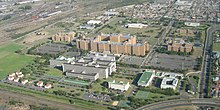
According to the South African Institute of Race Relations, the life expectancy in 2009 was 71 years for a white South African and 48 years for a black South African.[183] The healthcare spending in the country is about 9% of GDP.[184] About 84% of the population depends on the public healthcare system,[184] which is beset with chronic human resource shortages and limited resources.[185] About 20% of the population use private healthcare.[186] Only 16% of the population are covered by medical aid schemes;[187] the rest pay for private care out-of-pocket or through in-hospital-only plans.[186] The three dominant hospital groups, Mediclinic, Life Healthcare and Netcare, together control 75% of the private hospital market.[186]
HIV/AIDS

According to the 2015 UNAIDS medical report, South Africa has an estimated seven million people who are living with HIV – more than any other country in the world.[188] In 2018, HIV prevalence—the percentage of people living with HIV—among adults (15–49 years) was 20.4%, and in the same year 71,000 people died from an AIDS-related illness.[189]
A 2008 study revealed that HIV/AIDS infection is distinctly divided along racial lines: 13.6% of blacks are HIV-positive, whereas only 0.3% of whites have the virus.[190] Most deaths are experienced by economically active individuals, resulting in many AIDS orphans who in many cases depend on the state for care and financial support.[191] It is estimated that there are 1,200,000 orphans in South Africa.[191]
The link between HIV, a virus spread primarily by sexual contact, and AIDS was long denied by President Thabo Mbeki and his health minister Manto Tshabalala-Msimang, who insisted that the many deaths in the country are caused by malnutrition, and hence poverty, and not HIV.[192] In 2007, in response to international pressure, the government made efforts to fight AIDS.[193] After the 2009 general elections, President Jacob Zuma appointed Aaron Motsoaledi as the health minister and committed his government to increasing funding for and widening the scope of HIV treatment,[194] and by 2015, South Africa had made significant progress, with the widespread availability of antiretroviral drugs resulted in an increase in life expectancy from 52.1 years to 62.5 years.[195]
Urbanisation
One online database[196] lists South Africa having more than 12,600 cities and towns. The following are the largest cities and towns in South Africa.
| Rank | Name | Province | Pop. | ||||||
|---|---|---|---|---|---|---|---|---|---|
 Johannesburg  Cape Town |
1 | Johannesburg | Gauteng | 9,167,045 |  Durban  Pretoria | ||||
| 2 | Cape Town | Western Cape | 4,004,793 | ||||||
| 3 | Durban | KwaZulu-Natal | 3,661,911 | ||||||
| 4 | Pretoria | Gauteng | 2,437,000 | ||||||
| 5 | Gqeberha | Eastern Cape | 1,263,051 | ||||||
| 6 | Vereeniging | Gauteng | 957,528 | ||||||
| 7 | Soshanguve | Gauteng | 841,000 | ||||||
| 8 | East London | Eastern Cape | 810,528 | ||||||
| 9 | Bloemfontein | Free State | 759,693 | ||||||
| 10 | Pietermaritzburg | KwaZulu-Natal | 679,766 | ||||||
Government and politics
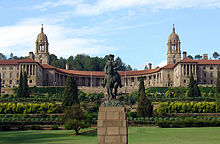

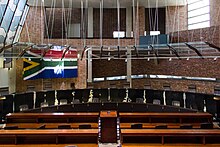
South Africa is a parliamentary republic, but unlike most such republics, the president is both head of state and head of government and depends for their tenure on the confidence of Parliament. The executive, legislature, and judiciary are all subject to the supremacy of the Constitution of South Africa, and the superior courts have the power to strike down executive actions and acts of Parliament if they are unconstitutional. The National Assembly, the lower house of Parliament, consists of 400 members and is elected every five years by a system of party-list proportional representation. The National Council of Provinces, the upper house, consists of ninety members, with each of the nine provincial legislatures electing ten members.
After each parliamentary election, the National Assembly elects one of its members as president; hence the president serves a term of office the same as that of the Assembly, normally five years. No president may serve more than two terms in office.[199] The president appoints a deputy president and ministers (each representing a department) who form the cabinet. The National Assembly may remove the president and the cabinet by a motion of no confidence. In the most recent election, held on 29 May 2024, the ANC lost its majority for the first time since the end of Apartheid,[200] winning only 40% of the vote and 159 seats, while the main opposition, the Democratic Alliance (DA), won 22% of the vote and 87 seats. uMkhonto weSizwe, a new party founded by former President and ANC leader Jacob Zuma, won 14.6% of the vote and 58 seats, while the Economic Freedom Fighters, founded by Julius Malema, former president of the ANC Youth League who was later expelled from the ANC, won 9.5% of the vote and 39 seats. After the election, the ANC formed a Government of National Unity with the DA and several smaller parties.[201]
South Africa has no legally defined capital city. The fourth chapter of the constitution states "The seat of Parliament is Cape Town, but an Act of Parliament enacted in accordance with section 76(1) and (5) may determine that the seat of Parliament is elsewhere."[202] The country's three branches of government are split over different cities. Cape Town, as the seat of Parliament, is the legislative capital; Pretoria, as the seat of the president and cabinet, is the administrative capital; and Bloemfontein is the seat of the Supreme Court of Appeal, and has traditionally been regarded as the judicial capital;[18] although the highest court, the Constitutional Court of South Africa has been based in Johannesburg since 1994. Most foreign embassies are located in Pretoria.
Since 2004, South Africa has had many thousands of popular protests,[203] some violent, making it, according to one academic, the "most protest-rich country in the world".[204] There have been numerous incidents of political repression as well as threats of future repression in violation of the constitution, leading some analysts and civil society organisations to conclude that there is or could be a new climate of political repression.[205][206]
In 2022, South Africa was placed sixth out of 48 sub-Saharan African countries on the Ibrahim Index of African Governance. South Africa scored well in the categories of Rule of Law, Transparency, Corruption, Participation and Human Rights, but scored low in Safety and Security.[207] In 2006, South Africa became one of the first jurisdictions in the world to legalise same-sex marriage.[208][209]
The Constitution of South Africa is the supreme rule of law in the country. The primary sources of South African law are Roman-Dutch mercantile law and personal law and English Common law, as imports of Dutch settlements and British colonialism.[210] The first European-based law in South Africa was brought by the Dutch East India Company and is called Roman-Dutch law. It was imported before the codification of European law into the Napoleonic Code and is comparable in many ways to Scots law. This was followed in the 19th century by English law, both common and statutory. After unification in 1910, South Africa had its own parliament which passed laws specific for South Africa, building on those previously passed for the individual member colonies. The judicial system consists of the magistrates' courts, which hear lesser criminal cases and smaller civil cases; the High Court, which has divisions that serve as the courts of general jurisdiction for specific areas; the Supreme Court of Appeal; and the Constitutional Court, which is the highest court.
Foreign relations
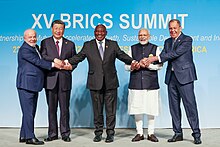
As the Union of South Africa, the country was a founding member of the United Nations (UN), with Prime Minister Jan Smuts writing the preamble to the UN Charter.[211][212] South Africa is one of the founding members of the African Union (AU) and has the largest economy of all the members. It is a founding member of the AU's New Partnership for Africa's Development. After apartheid ended, South Africa was readmitted to the Commonwealth of Nations. The country is a member of the Group of 77 and chaired the organisation in 2006. South Africa is also a member of the Southern African Development Community, South Atlantic Peace and Cooperation Zone, Southern African Customs Union, Antarctic Treaty System, World Trade Organization, International Monetary Fund, G20, G8+5, and the Port Management Association of Eastern and Southern Africa.
South Africa has played a key role as a mediator in African conflicts over the last decade, such as in Burundi, the Democratic Republic of the Congo, Comoros, Mozambique and Zimbabwe.
President Jacob Zuma and Chinese President Hu Jintao upgraded bilateral ties between the two countries in 2010 when they signed the Beijing Agreement which elevated South Africa's earlier "strategic partnership" with China to the higher level of "comprehensive strategic partnership" in both economic and political affairs, including the strengthening of exchanges between their respective ruling parties and legislatures.[213][214] In 2011, South Africa joined the Brazil-Russia-India-China (BRICS) grouping of countries, identified by Zuma as the country's largest trading partners and also the largest trading partners with Africa as a whole. Zuma asserted that BRICS member countries would also work with each other through the UN, G20, and the India, Brazil South Africa (IBSA) forum.[215]
Military
The South African National Defence Force (SANDF) was created in 1994[216][217] as a volunteer military composed of the former South African Defence Force, the forces of the African nationalist groups (uMkhonto we Sizwe and Azanian People's Liberation Army), and the former Bantustan defence forces.[216] The SANDF is subdivided into four branches, the South African Army, the South African Air Force, the South African Navy, and the South African Military Health Service.[218] The SANDF consists of around 75,000 professional soldiers as of 2019.[219] In recent years, the SANDF has become a major peacekeeping force in Africa,[220] and has been involved in operations in Lesotho, the DRC,[220] and Burundi,[220] amongst others. It has also served in multinational UN Peacekeeping forces such as the UN Force Intervention Brigade. In 2022 the nation spent US$3.069 billion on its armed forces which is about 0.86% of the nation's entire GDP. Over the years, defence expenditure has been cut as the nation currently faces no external military threats.[221]
The SANDF are often deployed in crime fighting and whenever the South African Police Service (SAPS) are no longer able to control the situation.[222] The 2021 South African unrest, South Africa's worst violence since the end of apartheid, saw the deployment of 25,000 troops, more than a dozen military helicopters and heavily armed vehicles deployed in the nation's KwaZulu-Natal and Gauteng provinces to assist the South African Police in ending the riots and looting. The largest deployment of troops since the end of apartheid was in March 2020, when 70,000 troops were deployed to enforce the nation's strict lockdown laws to combat the spread of COVID-19.[223] South Africa has military bases distributed all over the nation, including two naval bases and nine air force bases. The army maintains large bases in all nine provinces of the country.[224]
The South African Defence Industry is the most advanced on the African continent and one of the most advanced in the world.[225][226] As of 2020 South Africa is the world's 24th largest arms exporter, the only nation in Africa.[227] The nation designs many types of weapons that range from armored fighting vehicles to ballistic missiles, notable South African-made weapons include the Ratel IFV, the world's first wheeled infantry fighting vehicle, South Africa also made its own attack helicopter known as the "Rooivalk" which is known to be one of the most advanced attack helicopters in the world.[225] In recent years a R16 billion ($1 billion) contract was signed with the local defence industry which aims to produce 244 units of Badger IFV for the SANDF.[228]
South Africa is the only African country to have successfully developed nuclear weapons. It became the first country (followed by Ukraine) with nuclear capability to voluntarily renounce and dismantle its programme and in the process signed the Nuclear Non-Proliferation Treaty in 1991.[229] South Africa undertook a nuclear weapons programme in the 1970s.[229] South Africa is alleged to have conducted a nuclear test over the Atlantic in 1979,[230] although this is officially denied; de Klerk maintained that South Africa had "never conducted a clandestine nuclear test."[231] Six nuclear devices were completed between 1980 and 1990 but all were dismantled by 1991.[231] In 2017, South Africa signed the UN treaty on the Prohibition of Nuclear Weapons.[232]
Law enforcement and crime
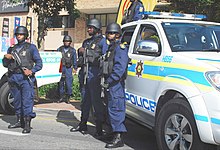
Law enforcement in South Africa is primarily the responsibility of the South African Police Service (SAPS), South Africa's national police force. SAPS is responsible for investigating crime and security throughout the country. The South African Police Service has over 1,154 police stations across the country and over 150,950 officers.[233] In 2023 the Special Task Force (SAPS) placed 9th at the international SWAT competition out of 55 law enforcement teams from across the world making it the best in Africa.[234]
South Africa has the world's largest private security industry,[235] with over 10,380 private security companies and 2.5 million private security personnel of which over 556,000 are active,[236] making it bigger than the South African Police Force and Military combined.[237] Private security mainly provide assistance to the South African Police Service (SAPS) to combat crime throughout the country. Over the years there has been tremendous growth in the private security industry.[238]
As of February 2023, South Africa has the sixth highest crime rate in the world.[239] From April 2017 to March 2018, on average 57 murders were committed each day in South Africa.[240] In the year ended March 2017, there were 20,336 murders and the murder rate was 35.9 per 100,000 – over five times higher than the global average of 6.2 per 100,000.[241] More than 526,000 South Africans were murdered from 1994 to 2019.[242]
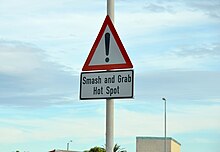
South Africa has a high rape rate, with 43,195 rapes reported in 2014/15, and an unknown number of sexual assaults going unreported.[243] A 2009 survey of 1,738 men in KwaZulu-Natal and the Eastern Cape by the Medical Research Council found one in four men admitted to raping someone,[244] and another survey of 4,000 women in Johannesburg by CIET Africa found one in three said they had been raped in the past year.[245] Rape occurs most commonly within relationships, but many men and women say that rape cannot occur in relationships; however, one in four women reported having been abused by an intimate partner.[246] Rapes are also perpetrated by children (some as young as ten).[247] The incidence of child and infant rape is among the highest in the world, largely as a result of the virgin cleansing myth, and a number of high-profile cases (sometimes as young as eight months)[247] have outraged the nation.[248]
Between 1994 and 2018, there were more than 500 xenophobic attacks against foreigners in South Africa.[249] The 2019 Johannesburg riots were similar in nature and origin to the 2008 xenophobic riots that also occurred in Johannesburg.[250]
Administrative divisions

Each of the nine provinces is governed by a unicameral legislature, which is elected every five years by party-list proportional representation. The legislature elects a premier as head of government, and the premier appoints an Executive Council as a provincial cabinet. The powers of provincial governments are limited to topics listed in the constitution; these topics include such fields as health, education, public housing and transport.
The provinces are in turn divided into 52 districts: 8 metropolitan and 44 district municipalities. The district municipalities are further subdivided into 205 local municipalities. The metropolitan municipalities, which govern the largest urban agglomerations, perform the functions of both district and local municipalities.
| Province | Provincial capital | Largest city | Area (km2)[251] | Population (2022)[151] |
|---|---|---|---|---|
| Eastern Cape | Bhisho | Gqeberha | 168,966 | 7,230,204 |
| Free State | Bloemfontein | Bloemfontein | 129,825 | 2,964,412 |
| Gauteng | Johannesburg | Johannesburg | 18,178 | 15,099,422 |
| KwaZulu-Natal | Pietermaritzburg | Durban | 94,361 | 12,423,907 |
| Limpopo | Polokwane | Polokwane | 125,754 | 6,572,720 |
| Mpumalanga | Mbombela | Mbombela | 76,495 | 5,143,324 |
| North West | Mahikeng | Klerksdorp | 104,882 | 3,804,548 |
| Northern Cape | Kimberley | Kimberley | 372,889 | 1,355,946 |
| Western Cape | Cape Town | Cape Town | 129,462 | 7,433,019 |
Economy
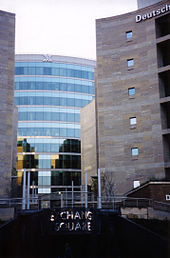
South Africa has a mixed economy. Its economy is Africa's largest, most technologically advanced and industrialised. It also has a relatively high gross domestic product (GDP) per capita compared to other countries in sub-Saharan Africa US$16,080 at purchasing power parity as of 2023 ranked 95th. However, South Africa is still burdened by a relatively high rate of poverty and unemployment and is ranked in the top ten countries in the world for income inequality,[253][254][255] measured by the Gini coefficient.
South Africa is ranked 40th by total wealth, making it the second wealthiest country in Africa, in terms of private wealth South Africa has a private wealth of $651 billion making South Africa's population the richest in Africa followed by Egypt with $307 billion and Nigeria with $228 billion.[256]
Approximately 55.5% (30.3 million people) of the population is living in poverty at the national upper poverty line while a total of 13.8 million people (25% of the population) are experiencing food poverty.[26]
In 2015, 71% of net wealth are held by 10% of the population, whereas 60% of the population held only 7% of the net wealth, and the Gini coefficient was 0.63, whereas in 1996 it was 0.61.[257]
Unlike most of the world's poor countries, South Africa does not have a thriving informal economy. Only 15% of South African jobs are in the informal sector, compared with around half in Brazil and India and nearly three-quarters in Indonesia. The Organisation for Economic Co-operation and Development (OECD) attributes this difference to South Africa's widespread welfare system.[258] World Bank research shows that South Africa has one of the widest gaps between per capita GDP versus its Human Development Index ranking, with only Botswana showing a larger gap.[259]
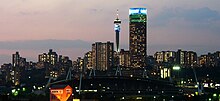
After 1994, government policy brought down inflation, stabilised public finances, and some foreign capital was attracted; however, growth was still below expectations.[261] From 2004 onward, economic growth picked up significantly; both employment and capital formation increased.[261] During the presidency of Jacob Zuma, the government increased the role of state-owned enterprises (SOEs). Some of the biggest SOEs are Eskom, the electric power monopoly, South African Airways (SAA), and Transnet, the railroad and ports monopoly. Some of these SOEs have not been profitable, such as SAA, which has required bailouts totaling R30 billion ($2.03 billion) over the 20 years preceding 2015.[262] Principal international trading partners of South Africa—besides other African countries—include Germany, the United States, China, Japan, the United Kingdom and Spain.[167] The 2020 Financial Secrecy Index ranked South Africa as the 58th safest tax haven in the world.[263]
The South African agricultural industry contributes around 10% of formal employment, relatively low compared to other parts of Africa, as well as providing work for casual labourers and contributing around 2.6% of GDP for the nation.[264] Due to the aridity of the land, only 13.5% can be used for crop production, and only 3% is considered high potential land.[265]
In August 2013, South Africa was ranked as the top African Country of the Future by fDi Intelligence based on the country's economic potential, labour environment, cost-effectiveness, infrastructure, business friendliness, and foreign direct investment strategy.[266]
Mining
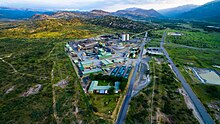
Mining has been a major component of South Africa's economy throughout its history. Until 2006 South Africa had been the world's largest gold producer for almost a century, by the end of 2009 gold mining in South Africa had declined rapidly, having produced 205 metric tons (mt) of gold in 2008 compared to 1,000 metric tons produced in 1970 (almost 80% of the world's mine supply at the time).[267] Despite this, the country still has 6,000 tonnes of gold reserves[268] and is still number 5 in gold production whilst remaining a supplier of a wide range of important mineral resources.[269] South Africa is home to the world's deepest gold mine, Mponeng Gold Mine, reaching nearly 4000m depth. [270] In 2015, South Africa's gold production was 145 metric tonnes.[271] It is the world's largest producer[272] of chrome, manganese, platinum, vanadium and vermiculite. It is the second largest producer[272] of ilmenite, palladium, rutile and zirconium. It is the world's third largest coal exporter.[273] It is a major producer of iron ore; in 2012, it overtook India to become the world's third-biggest iron ore supplier to China, the world's largest consumers of iron ore.[274]
Tourism
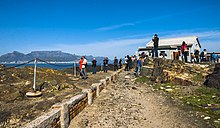
South Africa is a tourist destination with the tourist industry accounting for 2.34% of GDP[275] in 2019 followed by a sharp drop in 2020 to 0.81% of GDP[275] due to lack of travel caused by the COVID-19 pandemic. The official marketing agency for the country South African Tourism is responsible for marketing South Africa to the world. According to the World Travel & Tourism Council, the tourism industry directly contributed ZAR 102 billion to South African GDP in 2012, and supports 10.3% of jobs in the country.[276] The official national marketing agency of the South African government, with the goal of promoting tourism in South Africa both locally and globally is known as South African Tourism.[277]
South Africa offers both domestic and international tourists a wide variety of options, among others the picturesque natural landscape and game reserves, diverse cultural heritage and highly regarded wines. Some of the most popular destinations include several national parks, such as the expansive Kruger National Park in the north of the country, the coastlines and beaches of the KwaZulu-Natal and Western Cape provinces, and the major cities like Cape Town, Johannesburg and Durban.
According to Statistics South Africa's latest Tourism and Migration Survey, almost 3,5 million travellers passed through the country's ports of entry in August 2017.[278] The top five overseas countries with the largest number of tourists visiting South Africa were the US, UK, Germany, the Netherlands and France. Most of the tourists arriving in South Africa from elsewhere in Africa came from SADC countries. Zimbabwe tops the list at 31%, followed by Lesotho, Mozambique, Eswatini and Botswana. In addition, Nigeria was the country of origin for nearly 30% of tourists arriving in South Africa.[279]Infrastructure
Roads

South Africa has a total road network of 750,000 kilometres, the largest of any African country and the 12th largest in the world. According to SANRAL, the road network is valued at more than R2.1 trillion. SANRAL manages national roads and has a network of 22 197 kilometres of paved roads. Provinces are responsible for 222 951 kilometres while, according to the DoT, the municipal network is estimated at 275 661 kilometres of the proclaimed network. The rest are unproclaimed gravel roads (mainly serving rural communities) and are therefore not owned or maintained by any road authority. The country has more than 12 million motor vehicles with an average density of 16 motor vehicles per kilometre. The provincial road network is about 222 951 kilometres in length, consisting of 170 837 kilometres of unpaved and 52 114 kilometres of paved roads.[280]
Railways
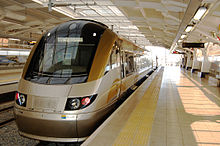
Rail transport in South Africa is an important element of the country's transport infrastructure. All major cities are connected by rail. Transnet Freight Rail mainly operates freight services while PRASA operates commuter services. State-owned utility Transnet Freight Rail is the largest freight rail transport operator on the African continent, the company maintains a rail network of approximately 31,000 kilometres but only 20,900 kilometres of this are in use.[281]
South Africa's railway system is the most developed and largest in Africa as well as the 13th largest in the world; however, vandalism, theft, and underinvestment has left left the overall condition of the majority of networks in a poor state.[282] Freight, passenger and port capacity shortages remain a severe constraint in domestic and regional trade.[283] Coal and iron ore are mainly transported on these lines. The country's rail network carried nearly 230 million tons of freight in 2017; however, this has declined to 179 million tons in 2021,[284]and it is likely that efforts will be made to revitalize these transport sectors through private sector partnerships.[285]
Airports

South Africa has international airports in six cities: Johannesburg, Cape Town, Durban, Port Elizabeth, Kimberley and Nelspruit.[286]
As of 2021, South Africa had 407 airports, making it the leading country in Africa in terms of airport ownership and the country ranked 20th globally.[287]
The four major airports in South Africa are: O.R. Tambo International Airport in Johannesburg, Cape Town International Airport, King Shaka International Airport in Durban and Chief Dawid Stuurman International Airport in Port Elizabeth.
O.R. Tambo International Airport in Johannesburg is Africa's largest and busiest airport which receives over 21 million passengers a year.[288] During the 2022 Skytrax World Airport Awards, Cape Town International Airport was voted the best airport on the African continent for the seventh consecutive year, Durban's King Shaka International Airport was voted the second best in Africa and Johannesburg's O.R. Tambo International Airport came third place.[289]
Energy
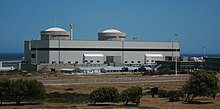
South Africa has a very large energy sector and is currently the only country on the African continent that possesses a nuclear power plant.[290] The country is the largest producer of electricity on the African continent and it ranks 21st globally.[291] South Africa is the 7th largest coal producer in the world and produces in excess of 248 million tonnes of coal and consumes almost three-quarters of that domestically. Around 77% of South Africa's energy needs are directly derived from coal and 92% of coal consumed on the African continent is mined in South Africa. South Africa is also the world's 14th largest emitter of greenhouse gases.[292]
The country's primary electricity generator is Eskom, the utility is the largest producer of electricity in Africa, and is among the top seven utilities in the world in terms of generation capacity and among the top nine in terms of sales.[293] It is the largest of South Africa's state owned enterprises. Eskom generates approximately 95% of electricity in South Africa and operates a number of notable power stations, including the Koeberg Nuclear Power Station in Cape Town, the only nuclear power plant in Africa, Kendal Power Station, the largest dry-cooled power station in the world,[294] as well as Duvha Power Station which became the first power station in the world to be retrofitted with pulse jet fabric filter plants.[295] In 2001 Eskom was named the best electricity utility in the entire world.[293]
Energy crisis
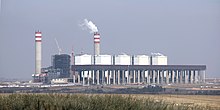
Due to severe mismanagement and corruption at Eskom, the company is R392bn ($22bn) in debt and is unable to meet the demands of the South African power grid.[297] Due to this, Eskom implemented loadshedding for the first time in 2007, which is periodically switching off electricity to specific power grids in specific time frames. This was done to prevent a failure of the entire system when the demand for electricity strains the capacity of Eskom's power generating system. Load shedding is characterized by periods of widespread national-level rolling blackouts.[298] Crime such as theft, and sabotage at Eskom power stations had also been a significant issue contributing to South Africa's energy crisis.[299]
The government and Eskom have made significant strides toward resolving the issues that have plagued the power system for years. Key to this progress has been a focus on improving maintenance of its coal-fired power plants, reducing frequent breakdowns that caused widespread load shedding. In addition, there has been a noticeable increase in the contribution of renewable energy sources, such as solar and wind, from independent power producers (IPPs), which has helped diversify South Africa's energy mix and reduce reliance on coal.[300]
In addition, energy supply has stabilized, with no (planned power cuts) since late March 2024. Prior to this, electricity supply shortages had constrained South Africa’s growth for several years. The cumulated duration of the outages due to rotational load shedding, each of which lasted 2 to 4 hours, was equivalent to 289 days in 2023, up from 157 in 2022 and 48 in 2021. This severe electricity shortfall disrupted economic activity and increased operating costs for businesses, many of which rely on costly diesel generators. However, there are subsequent improvements in electricity supply which have been attributed to improvements in the management of the national power utility Eskom, and high-level political support from the President and the Minister of Electricity.
Science and technology

Several important scientific and technological developments have originated in South Africa. South Africa was ranked 69th in the Global Innovation Index in 2024.[301] The first human-to-human heart transplant was performed by cardiac surgeon Christiaan Barnard at Groote Schuur Hospital in December 1967; Max Theiler developed a vaccine against yellow fever, Allan MacLeod Cormack pioneered X-ray computed tomography (CT scan); and Aaron Klug developed crystallographic electron microscopy techniques. Cormack and Klug received Nobel Prizes for their work. Sydney Brenner won in 2002, for his pioneering work in molecular biology. Mark Shuttleworth founded an early Internet security company Thawte.[302]
South Africa has cultivated a burgeoning astronomy community. It hosts the Southern African Large Telescope, the largest optical telescope in the Southern Hemisphere. South Africa is currently building the Karoo Array Telescope as a pathfinder for the €1.5 billion Square Kilometre Array project.[303]
Transport

Modes of transport include roads, railways, airports, water, and pipelines for petroleum oil. The majority of people in South Africa use informal minibus taxis as their main mode of transport. Bus rapid transit has been implemented in some cities in an attempt to provide more formalised and safer public transport services. South Africa has many major ports including Cape Town, Durban, and Port Elizabeth that allow ships and other boats to pass through, some carrying passengers and some carrying petroleum tankers.
Water supply and sanitation
Two distinctive features of the South African water sector are the policy of free basic water and the existence of water boards, which are bulk water supply agencies that operate pipelines and sell water from reservoirs to municipalities. These features have led to significant problems concerning the financial sustainability of service providers, leading to a lack of attention to maintenance. Following the end of apartheid, the country had made improvements in the levels of access to water as those with access increased from 66% to 79% from 1990 to 2010.[304] Sanitation access increased from 71% to 79% during the same period.[304] However, water supply and sanitation has come under increasing pressure in recent years despite a commitment made by the government to improve service standards and provide investment subsidies to the water industry.[305]
The eastern parts of South Africa suffer from periodic droughts linked to the El Niño weather phenomenon.[306] In early 2018, Cape Town, which has different weather patterns to the rest of the country,[306] faced a water crisis as the city's water supply was predicted to run dry before the end of June. Water-saving measures were in effect that required each citizen to use less than 50 litres (13 US gal) per day.[307] Cape Town rejected an offer from Israel to help it build desalination plants.[308][309][310][311]
Culture
The South African black majority still has a substantial number of rural inhabitants who lead largely impoverished lives. It is among these people that cultural traditions survive most strongly; as blacks have become increasingly urbanised and Westernised, aspects of traditional culture have declined. Members of the middle class, who have historically been predominantly white but whose ranks include growing numbers of black, Coloured and Indian people,[312][313] have lifestyles similar in many respects to that of people found in Western Europe, North America and Australasia.
Arts

South African art includes the oldest art objects in the world, which were discovered in a South African cave and dated from roughly 75,000 years ago.[314] The scattered tribes of the Khoisan peoples moving into South Africa from around 10,000 BC had their own fluent art styles seen today in a multitude of cave paintings. They were superseded by the Bantu/Nguni peoples with their own vocabularies of art forms. Forms of art evolved in the mines and townships: a dynamic art using everything from plastic strips to bicycle spokes. The Dutch-influenced folk art of the Afrikaner trekboers and the urban white artists, earnestly following changing European traditions from the 1850s onwards, also contributed to this eclectic mix which continues to evolve to this day.
Popular culture
The South African media sector is large, and South Africa is one of Africa's major media centres. While the many broadcasters and publications reflect the diversity of the population as a whole, the most commonly used language is English. However, all ten other official languages are represented to some extent or another.
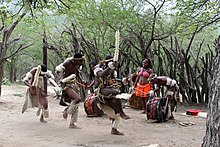
There is great diversity in South African music. Black musicians have developed unique styles called Kwaito and Amapiano, that is said to have taken over radio, television, and magazines.[315] Of note is Brenda Fassie, who launched to fame with her song "Weekend Special", which was sung in English. More famous traditional musicians include Ladysmith Black Mambazo, while the Soweto String Quartet performs classical music with an African flavour. South Africa has produced world-famous jazz musicians, notably Hugh Masekela, Jonas Gwangwa, Abdullah Ibrahim, Miriam Makeba, Jonathan Butler, Chris McGregor, and Sathima Bea Benjamin. Afrikaans music covers multiple genres, such as the contemporary Steve Hofmeyr, the punk rock band Fokofpolisiekar, and the singer-songwriter Jeremy Loops. South African popular musicians that have found international success include Manfred Mann, Johnny Clegg, rap-rave duo Die Antwoord, Tyla, and rock band Seether. Rappers such as AKA, Nasty C and Cassper Nyovest gained notoriety in other avenues like the BET Awards for best African acts.
Although few South African film productions are known outside South Africa, many foreign films have been produced about South Africa. Arguably, the most high-profile film portraying South Africa in recent years was District 9 and its upcoming sequel, as well as Chappie. Other notable exceptions are the film Tsotsi, which won the Academy Award for Foreign Language Film at the 78th Academy Awards in 2006, as well as U-Carmen e-Khayelitsha, which won the Golden Bear at the 2005 Berlin International Film Festival. In 2015, the Oliver Hermanus film The Endless River became the first South African film selected for the Venice Film Festival.
Literature
South African literature emerged from a unique social and political history. One of the first well known novels written by a black author in an African language was Solomon Thekiso Plaatje's Mhudi, written in 1930. During the 1950s, Drum magazine became a hotbed of political satire, fiction, and essays, giving a voice to the urban black culture.
Notable white South African authors include anti-apartheid activist Alan Paton, who published the novel Cry, the Beloved Country in 1948. Nadine Gordimer became the first South African to be awarded the Nobel Prize in Literature, in 1991. J.M. Coetzee won the Nobel Prize in Literature in 2003. When awarding the prize, the Swedish Academy stated that Coetzee "in innumerable guises portrays the surprising involvement of the outsider."[316]
The plays of Athol Fugard have been regularly premiered in fringe theatres in South Africa, London (Royal Court Theatre) and New York. Olive Schreiner's The Story of an African Farm (1883) was a revelation in Victorian literature: it is heralded by many as introducing feminism into the novel form.
Breyten Breytenbach was jailed for his involvement with the guerrilla movement against apartheid.[317] André Brink was the first Afrikaner writer to be banned by the government after he released the novel A Dry White Season.[318]
Cuisine
The cuisine of South Africa is diverse, and foods from many different cultures and backgrounds are enjoyed by all communities, and especially marketed to tourists who wish to sample the large variety available. The cuisine is mostly meat-based and has spawned the distinctively South African social gathering known as the braai, a variation of the barbecue. South Africa has also developed into a major wine producer, with some of the best vineyards lying in valleys around Stellenbosch, Franschhoek, Paarl and Barrydale.[319]
Sports

South Africa's most popular sports are association football, rugby union and cricket.[320] Other sports with significant support are swimming, athletics, golf, boxing, tennis, rugby league, ringball, field hockey, surfing and netball. Although football (soccer) commands the greatest following among the youth, other sports like basketball, judo, softball and skateboarding are becoming increasingly popular amongst the populace.[321]
Association football is the most popular sport in South Africa.[322][323][324] Footballers who have played for major foreign clubs include Steven Pienaar, Lucas Radebe, Philemon Masinga, Benni McCarthy, Aaron Mokoena, and Delron Buckley. South Africa hosted the 2010 FIFA World Cup, and FIFA president Sepp Blatter awarded South Africa a grade 9 out of 10 for successfully hosting the event.[325] Player Benni McCarthy is also a first-team coach for the English football club Manchester United.[326] It hosted the 1996 African Cup of Nations, with the national team Bafana Bafana going on to win the tournament. In 2022, the women's team also won the Women's Africa Cup of Nations, beating Morocco 2–1 in the final. The women's team went on to reach the last 16 at the 2023 FIFA Women's World Cup, beating Italy and tying with Argentina in the group stage.
Famous combat sport personalities include Baby Jake Jacob Matlala, Vuyani Bungu, Welcome Ncita, Dingaan Thobela, Corrie Sanders, Gerrie Coetzee, Brian Mitchell and Dricus du Plessis. Durban surfer Jordy Smith won the 2010 Billabong J-Bay Open making him the highest ranked surfer in the world. South Africa produced Formula One motor racing's 1979 world champion Jody Scheckter. Famous active Grand Prix motorcycle racing personalities include Brad Binder and his younger brother Darryn Binder. Well-known active cricket players include Kagiso Rabada, David Miller, Keshav Maharaj, Quinton de Kock, Lungi Ngidi, Anrich Nortje, Aiden Markram and Faf du Plessis; some also participate in the Indian Premier League.

South Africa has produced numerous world class rugby players, including Francois Pienaar, Joost van der Westhuizen, John Smit, Os du Randt, Jean de Villiers, Chester Williams, Frans Steyn, Victor Matfield, Bryan Habana, Tendai Mtawarira, Eben Etzebeth, Cheslin Kolbe and Siya Kolisi. South Africa has won the Rugby World Cup four times, the most wins of any country. South Africa first won the 1995 Rugby World Cup, which it hosted. They went on to win the tournament again in 2007, 2019 and 2023.[327]
Cricket is one of the most played sports in South Africa. It has hosted the 2003 Cricket World Cup, the 2007 World Twenty20 Championship. South Africa's national cricket team, the Proteas, have also won the inaugural edition of the 1998 ICC KnockOut Trophy by defeating West Indies in the final. The 2023 ICC Women's T20 World Cup was hosted in South Africa and the women's team won silver. The men's team won silver at the 2024 ICC T20 World Cup. South Africa's national blind cricket team also went on to win the inaugural edition of the Blind Cricket World Cup in 1998.[328]
In 2004, the swimming team of Roland Schoeman, Lyndon Ferns, Darian Townsend and Ryk Neethling won the gold medal at the Olympic Games in Athens, simultaneously breaking the world record in the 4×100 Freestyle Relay. Penny Heyns won Olympic Gold in the 1996 Atlanta Olympic Games, and more recently, swimmers Tatjana Smith (née Schoenmaker), Lara van Niekerk, Akani Simbine and Wayde van Niekerk have all broken records and won medals at both the Olympic and Commonwealth Games, with Wayde van Niekerk being the world record holder in 400 metres since 2016. In 2012, Oscar Pistorius became the first double amputee sprinter to compete at the Olympic Games in London. Gary Player is regarded as one of the greatest golfers of all time, having won the Career Grand Slam, one of five to have done so.[329]
See also
References
- ^ Constitution Eighteenth Amendment Act (47665) (in English and Tswana). Vol. 697. Parliament of the Republic of South Africa. 27 July 2023.
- ^ "Principal Agglomerations of the World". City Population. Archived from the original on 25 December 2018. Retrieved 30 October 2011.
- ^ a b c "South Africa at a glance". South African Government. Archived from the original on 26 May 2020. Retrieved 18 June 2020.
- ^ a b The Constitution of the Republic of South Africa (PDF) (2013 English version ed.). Constitutional Court of South Africa. 2013. ch. 1, s. 6. Archived (PDF) from the original on 23 August 2018. Retrieved 17 April 2020.
- ^ a b c "The NA Approves South African Sign Language as the 12th Official Language". Parliament of South Africa. 3 May 2023. Archived from the original on 22 December 2023.
- ^ Mitchley, Alex. "SA's population swells to 62 million - 2022 census at a glance". News24. Archived from the original on 11 October 2023. Retrieved 11 October 2023.
- ^ "Statistical Release - Census 2022" (PDF). statssa.gov.za. Retrieved 22 August 2024.
- ^ a b c d "Census 2022 Statistical Release" (PDF). Statistics South Africa. Archived (PDF) from the original on 15 October 2023. Retrieved 15 October 2023.
- ^ a b c d "World Economic Outlook Database, April 2024 Edition. (South Africa)". www.imf.org. International Monetary Fund. 16 April 2024. Archived from the original on 16 April 2024. Retrieved 17 April 2024.
- ^ "Gini Index". World Bank. Archived from the original on 29 May 2020. Retrieved 25 September 2018.
- ^ "Human Development Report 2023/24" (PDF). United Nations Development Programme. 13 March 2024. p. 275. Archived (PDF) from the original on 13 March 2024. Retrieved 13 March 2024.
- ^ "Data Source Comparison for en-ZA". www.localeplanet.com. Archived from the original on 16 August 2021. Retrieved 5 May 2021.
- ^ "Data Source Comparison for af-ZA". www.localeplanet.com. Archived from the original on 5 May 2021. Retrieved 5 May 2021.
- ^ "South African Maritime Safety Authority". South African Maritime Safety Authority. Archived from the original on 29 December 2008. Retrieved 16 June 2008.
- ^ "Coastline". The World Factbook. CIA. Archived from the original on 16 July 2017. Retrieved 16 June 2008.
- ^ "South Africa Fast Facts". SouthAfrica.info. April 2007. Archived from the original on 19 July 2008. Retrieved 14 June 2008.
- ^ Guy Arnold. "Lesotho: Year In Review 1996 – Britannica Online Encyclopedia". Encyclopædia Britannica. Archived from the original on 15 June 2013. Retrieved 30 October 2011.
- ^ a b Marais, Lochner; Twala, Chitja (7 May 2020). "Bloemfontein: the rise and fall of South Africa's judicial capital". African Geographical Review. 40 (1). Informa UK Limited: 49–62. doi:10.1080/19376812.2020.1760901. ISSN 1937-6812. S2CID 218929562.
- ^ "Rainbow Nation – dream or reality?". BBC News. 18 July 2008. Archived from the original on 8 September 2013. Retrieved 10 August 2013.
- ^ Cooper, Andrew F; Antkiewicz, Agata; Shaw, Timothy M (10 December 2007). "Lessons from/for BRICSAM about South-North Relations at the Start of the 21st Century: Economic Size Trumps All Else?". International Studies Review. 9 (4): 675, 687. doi:10.1111/j.1468-2486.2007.00730.x. ISSN 1468-2486.
- ^ Lynch, David A. (2010). Trade and Globalization: An Introduction to Regional Trade Agreements. Rowman & Littlefield. p. 51. ISBN 978-0-7425-6689-7. Archived from the original on 11 October 2013. Retrieved 25 August 2013.
Southern Africa is home to the other of sub-Saharan Africa's regional powers: South Africa. South Africa is more than just a regional power; it is currently the most developed and economically powerful country in Africa, and is able to use that influence in Africa more than during the days of apartheid, when it was ostracised from the rest of the world.
- ^ "South Africa". World Bank. Archived from the original on 1 November 2011. Retrieved 23 July 2021.
- ^ Waugh, David (2000). "Manufacturing industries (chapter 19), World development (chapter 22)". Geography: An Integrated Approach. Nelson Thornes. pp. 563, 576–579, 633, 640. ISBN 978-0-17-444706-1. Archived from the original on 11 October 2013. Retrieved 24 August 2013.
- ^ "World Heritage List". UNESCO World Heritage Centre. Retrieved 16 August 2024.
- ^ Lieberman, Evan (2022). Until We Have Won Our Liberty. Princeton University Press. ISBN 978-0-691-20300-3. Archived from the original on 24 November 2021. Retrieved 25 November 2021.
- ^ a b ""World Bank" : South Africa" (PDF). Archived (PDF) from the original on 20 April 2023. Retrieved 7 April 2023.
- ^ "World Bank Open Data". World Bank Open Data. Archived from the original on 4 April 2024. Retrieved 4 April 2024.
- ^ Francis, David; Webster, Edward (2 November 2019). "Poverty and inequality in South Africa: critical reflections". Development Southern Africa. 36 (6): 788–802. doi:10.1080/0376835X.2019.1666703. ISSN 0376-835X. Archived from the original on 4 April 2024. Retrieved 4 April 2024.
- ^ "The text". www.concourt.org.za. Archived from the original on 25 December 2023. Retrieved 25 December 2023.
- ^ South African Sign Language is also an official language
- ^ Livermon, Xavier (2008). "Sounds in the City". In Nuttall, Sarah; Mbembé, Achille (eds.). Johannesburg: The Elusive Metropolis. Durham: Duke University Press. p. 283. ISBN 978-0-8223-8121-1. Archived from the original on 2 May 2019. Retrieved 5 January 2016.
Mzansi is another black urban vernacular term popular with the youth and standing for South Africa.
- ^ "Mzansi DiToloki". Deaf Federation of South Africa. Archived from the original on 16 January 2014. Retrieved 15 January 2014.
uMzantsi in Xhosa means 'south', Mzansi means this country, South Africa
- ^ Taylor, Darren. "South African Party Says Call Their Country 'Azania'". VOA. Archived from the original on 24 June 2016. Retrieved 18 February 2017.
- ^ Wymer, John; Singer, R (1982). The Middle Stone Age at Klasies River Mouth in South Africa. Chicago: University of Chicago Press. ISBN 978-0-226-76103-9.
- ^ Deacon, HJ (2001). "Guide to Klasies River" (PDF). Stellenbosch University. p. 11. Archived (PDF) from the original on 21 February 2011. Retrieved 5 September 2009.
- ^ "Fossil Hominid Sites of South Africa". UNESCO World Heritage Centre. Archived from the original on 4 December 2019. Retrieved 26 December 2019.
- ^ Marean, Curtis W. (September 2010). "Pinnacle Point Cave 13B (Western Cape Province, South Africa) in context: The Cape Floral kingdom, shellfish, and modern human origins". Journal of Human Evolution. 59 (3–4): 425–443. Bibcode:2010JHumE..59..425M. doi:10.1016/j.jhevol.2010.07.011. PMID 20934095.
- ^ Broker, Stephen P. "Hominid Evolution". Yale-New Haven Teachers Institute. Archived from the original on 7 April 2008. Retrieved 19 June 2008.
- ^ Langer, William L., ed. (1972). An Encyclopedia of World History (5th ed.). Boston: Houghton Mifflin Company. p. 9. ISBN 978-0-395-13592-1.
- ^
Leakey, Louis Seymour Bazett (1936). "Stone Age cultures of South Africa". Stone age Africa: an outline of prehistory in Africa (reprint ed.). Negro Universities Press. p. 79. ISBN 9780837120225. Retrieved 21 February 2018.
In 1929, during a brief visit to the Transvaal, I myself found a number of pebble tools in some of the terrace gravels of the Vaal River, and similar finds have been recorded by Wayland, who visited South Africa, and by van Riet Lowe and other South African prehistorians.
- ^ Alfred, Luke. "The Bakoni: From prosperity to extinction in a generation". Citypress. Archived from the original on 20 October 2020. Retrieved 13 September 2020.
- ^ "Adam's Calendar in Waterval Boven, Mpumalanga". www.sa-venues.com. Archived from the original on 17 December 2020. Retrieved 13 September 2020.
- ^ Chirikure, Shadreck; Delius, Peter; Esterhuysen, Amanda; Hall, Simon; Lekgoathi, Sekibakiba; Maulaudzi, Maanda; Neluvhalani, Vele; Ntsoane, Otsile; Pearce, David (1 October 2015). Mapungubwe Reconsidered: A Living Legacy: Exploring Beyond the Rise and Decline of the Mapungubwe State. Real African Publishers Pty Ltd. ISBN 978-1-920655-06-8.
- ^ Domville-Fife, C.W. (1900). The encyclopedia of the British Empire the first encyclopedic record of the greatest empire in the history of the world ed. London: Rankin. p. 25.
- ^ Mackenzie, W. Douglas; Stead, Alfred (1899). South Africa: Its History, Heroes, and Wars. Chicago: The Co-Operative Publishing Company.
- ^ Pakeman, SA. Nations of the Modern World: Ceylon (1964 ed.). Frederick A Praeger, Publishers. pp. 18–19.
- ^ a b c Wilmot, Alexander & John Centlivres Chase. History of the Colony of the Cape of Good Hope: From Its Discovery to the Year 1819 (2010 ed.). Claremont: David Philip (Pty) Ltd. pp. 1–548. ISBN 978-1-144-83015-9.
- ^ Kaplan, Irving. Area Handbook for the Republic of South Africa (PDF). pp. 46–771. Archived (PDF) from the original on 28 April 2015. Retrieved 30 May 2015.
- ^ "African History Timeline". West Chester University of Pennsylvania. Archived from the original on 7 January 2009. Retrieved 16 June 2008.
- ^ a b Hunt, John (2005). Campbell, Heather-Ann (ed.). Dutch South Africa: Early Settlers at the Cape, 1652–1708. Philadelphia: University of Pennsylvania Press. pp. 13–35. ISBN 978-1-904744-95-5.
- ^ Worden, Nigel (5 August 2010). Slavery in Dutch South Africa (2010 ed.). Cambridge University Press. pp. 40–43. ISBN 978-0-521-15266-2.
- ^ a b Nelson, Harold. Zimbabwe: A Country Study. pp. 237–317.
- ^ Elphick, R (1993). Khoikhoi and the Founding of White South Africa (1st ed.). Johannesburg: Ravan Press. p. 240.
- ^ a b c d e Stapleton, Timothy (2010). A Military History of South Africa: From the Dutch-Khoi Wars to the End of Apartheid. Santa Barbara: Praeger Security International. pp. 4–6. ISBN 978-0-313-36589-8.
- ^ Keegan, Timothy (1996). Colonial South Africa and the Origins of the Racial Order (1996 ed.). David Philip Publishers (Pty) Ltd. pp. 85–86. ISBN 978-0-8139-1735-1.
- ^ a b c Lloyd, Trevor Owen (1997). The British Empire, 1558–1995. Oxford: Oxford University Press. pp. 201–203. ISBN 978-0-19-873133-7.
- ^ Eldredge, "Sources of Conflict in Southern Africa," 28.
- ^ Wright, "Turbulent Times," 250.
- ^ a b Wright, "Turbulent Times," 225-226.
- ^ Wright, "Turbulent Times," 233.
- ^ Wright, "Turbulent Times," 227.
- ^ Wright, "Turbulent Times," 249.
- ^ Hillier, Alfred Peter; Cana, Frank Richardson (1911). . Encyclopædia Britannica. Vol. 20 (11th ed.). pp. 151–160.
- ^ Wright, "Turbulent Times," 215.
- ^ Wright, "Turbulent Times," 235.
- ^ Williams, Garner F (1905). The Diamond Mines of South Africa, Vol II. New York: B. F Buck & Co. pp. Chapter XX. Archived from the original on 31 July 2012. Retrieved 27 November 2008.
- ^ "South African Military History Society – Journal- THE SEKUKUNI WARS". samilitaryhistory.org. Archived from the original on 23 July 2020. Retrieved 15 August 2020.
- ^ Knight, Ian (6 May 2011). Zulu Rising: The Epic Story of Isandlwana and Rorke's Drift. Pan Macmillan. ISBN 9781447202233. Archived from the original on 28 June 2024. Retrieved 26 December 2023.
- ^ "5 of the worst atrocities carried out by the British Empire". The Independent. 19 January 2016. Archived from the original on 27 September 2019. Retrieved 22 September 2019.
- ^ Ogura, Mitsuo (1996). "Urbanization and Apartheid in South Africa: Influx Controls and Their Abolition". The Developing Economies. 34 (4): 402–423. doi:10.1111/j.1746-1049.1996.tb01178.x. ISSN 1746-1049. PMID 12292280.
- ^ Bond, Patrick (1999). Cities of gold, townships of coal: essays on South Africa's new urban crisis. Africa World Press. p. 140. ISBN 978-0-86543-611-4.
- ^ Report of the Select Committee on Location Act (Report). Cape Times Limited. 1906. Retrieved 30 July 2009.
- ^ Godley, Godfrey; Archibald, Welsh; Thomson, William; Hemsworth, H. D. (1920). Report of the Inter-departmental committee on the native pass laws (Report). Cape Times Limited. p. 2.
- ^ Papers relating to legislation affecting natives in the Transvaal (Report). Great Britain Colonial Office; Transvaal (Colony). Governor (1901–1905: Milner). January 1902.
- ^ De Villiers, John Abraham Jacob (1896). The Transvaal. London: Chatto & Windus. pp. 30 (n46). Retrieved 30 July 2009.
- ^ Cana, Frank Richardson (1911). . In Chisholm, Hugh (ed.). Encyclopædia Britannica. Vol. 25 (11th ed.). Cambridge University Press. p. 467.
- ^ "Native Land Act". South African Institute of Race Relations. 19 June 1913. Archived from the original on 14 October 2010.
- ^ "National Party (NP) | South African History Online". www.sahistory.org.za. Archived from the original on 8 May 2020. Retrieved 25 December 2023.
- ^ Gloria Galloway, "Chiefs Reflect on Apartheid" Archived 2 May 2019 at the Wayback Machine, The Globe and Mail, 11 December 2013
- ^ Beinart, William (2001). Twentieth-century South Africa. Oxford University Press. p. 202. ISBN 978-0-19-289318-5.
- ^ "apartheid | South Africa, Definition, Facts, Beginning, & End". Britannica. Archived from the original on 7 May 2022. Retrieved 15 May 2022.
- ^ "Hendrik Frensch Verwoerd". South African History Online. Archived from the original on 29 November 2017. Retrieved 9 March 2013.
On 5 October 1960 a referendum was held in which White voters were asked: "Do you support a republic for the Union?" – 52 percent voted 'Yes'.
- ^ Gibson, Nigel; Alexander, Amanda; Mngxitama, Andile (2008). Biko Lives! Contesting the Legacies of Steve Biko. Hampshire: Palgrave Macmillan. p. 138. ISBN 978-0-230-60649-4.
- ^ Switzer, Les (2000). South Africa's Resistance Press: Alternative Voices in the Last Generation Under Apartheid. Issue 74 of Research in international studies: Africa series. Ohio University Press. p. 2. ISBN 978-0-89680-213-1. Archived from the original on 11 December 2020. Retrieved 19 October 2020.
- ^ Mitchell, Thomas (2008). Native vs Settler: Ethnic Conflict in Israel/Palestine, Northern Ireland and South Africa. Westport: Greenwood Publishing Group. pp. 194–196. ISBN 978-0-313-31357-8.
- ^ Bridgland, Fred (1990). The War for Africa: Twelve months that transformed a continent. Gibraltar: Ashanti Publishing. p. 32. ISBN 978-1-874800-12-5.
- ^ Landgren, Signe (1989). Embargo Disimplemented: South Africa's Military Industry (1989 ed.). Oxford University Press. pp. 6–10. ISBN 978-0-19-829127-5.
- ^ "South Africa". www.sadc.int. Archived from the original on 25 December 2023. Retrieved 25 December 2023.
- ^ "Post-Apartheid South Africa: the First Ten Years – Unemployment and the Labor Market" (PDF). IMF. Archived (PDF) from the original on 29 July 2013. Retrieved 16 February 2013.
- ^ "Zuma surprised at level of white poverty". Mail & Guardian. 18 April 2008. Archived from the original on 29 July 2013. Retrieved 30 May 2010.
- ^ "South Africa". Human Development Report. United Nations Development Programme. 2006. Archived from the original on 29 November 2007. Retrieved 28 November 2007.
- ^ "2015 United Nations Human Development Report" (PDF). Archived from the original (PDF) on 22 December 2015. Retrieved 5 August 2018.
- ^ "South African Life Expectancy at Birth, World Bank". Archived from the original on 6 August 2018. Retrieved 5 August 2018.
- ^ "Ridicule succeeds where leadership failed on AIDS". South African Institute of Race Relations. 10 November 2006.[dead link]
- ^ a b Chance, Kerry (20 June 2008). "Broke-on-Broke Violence". Slate. Archived from the original on 8 September 2011. Retrieved 6 July 2011.
- ^ "COHRE statement on Xenophobic Attacks". 2 June 2008. Archived from the original on 18 January 2012. Retrieved 6 July 2011.
- ^ Southern African Migration Project; Institute for Democracy in South Africa; Queen's University (2008). Jonathan Crush (ed.). The perfect storm: the realities of xenophobia in contemporary South Africa (PDF). Idasa. p. 1. ISBN 978-1-920118-71-6. Archived from the original (PDF) on 30 July 2013. Retrieved 26 June 2013.
- ^ a b c d "UNHCR Global Appeal 2011 – South Africa". United Nations High Commissioner for Refugees. Archived from the original on 11 May 2013. Retrieved 30 October 2011.
- ^ Harris, Bronwyn (2004). Arranging prejudice: Exploring hate crime in post-apartheid South Africa (PDF) (Report). Cape Town: Centre for the Study of Violence and Reconciliation. Archived (PDF) from the original on 28 May 2024. Retrieved 10 June 2024.
- ^ Traum, Alexander (2014). "Contextualising the hate speech debate: the United States and South Africa". The Comparative and International Law Journal of Southern Africa. 47 (1): 64–88. ISSN 0010-4051. JSTOR 24585817. Archived from the original on 10 June 2024. Retrieved 10 June 2024.
- ^ Campbell, John (15 July 2021). "South Africa Sees the Best of Times and the Worst of Times". Council on Foreign Relations. Archived from the original on 4 June 2024. Retrieved 4 June 2024.
- ^ Sguazzin, Antony (10 September 2020). "South Africa Heading Toward Becoming a Failed State, Group Says". Bloomberg. Archived from the original on 24 April 2022. Retrieved 4 June 2024.
- ^ Hattingh, Chris (20 July 2021). "South Africa Descends Into Looting and Violence Amid Economic Turmoil". Foundation for Economic Education. Archived from the original on 4 June 2024. Retrieved 4 June 2024.
- ^ Levy, Brian; Hirsch, Alan; Naidoo, Vinothan; Nxele, Musa (18 March 2021). "South Africa: When Strong Institutions and Massive Inequalities Collide". Carnegie Endowment for International Peace. Archived from the original on 27 June 2024. Retrieved 4 June 2024.
- ^ Poplak, Richard (13 July 2021). "This is what a failed state looks like". Daily Maverick. Archived from the original on 4 June 2024. Retrieved 4 June 2024.
- ^ Head, Tom (6 March 2022). "SA heading towards 'failed state' territory - according to our own Treasury". The South African. Archived from the original on 4 December 2022. Retrieved 4 June 2024.
- ^ Pawle, Lucy (9 October 2020). "Ferraris and frustration: Two faces of South Africa's corruption battle". BBC News. Archived from the original on 4 June 2024. Retrieved 4 June 2024.
- ^ Momoniat, Ismail (10 April 2023). "How and Why Did State Capture and Massive Corruption Occur in South Africa ?". International Monetary Fund. Archived from the original on 4 June 2024. Retrieved 4 June 2024.
- ^ Maseko, Nomsa (23 June 2022). "South Africa's Zondo commission: Damning report exposes rampant corruption". BBC News. Archived from the original on 4 June 2024. Retrieved 4 June 2024.
- ^ a b "The Zondo Commission: A bite-sized summary". Public Affairs Research Institute, University of the Witwatersrand. 5 September 2022. Archived from the original on 4 June 2024. Retrieved 4 June 2024.
- ^ Imray, Gerald (5 December 2023). "Hamas officials join Nelson Mandela's family at ceremony marking 10th anniversary of his death". AP News. Archived from the original on 4 June 2024. Retrieved 4 June 2024.
- ^ Ahren, Raphael (19 October 2015). "Jerusalem fumes as South Africa hosts Hamas chiefs". The Times of Israel. Archived from the original on 24 May 2024. Retrieved 4 June 2024.
- ^ Chothia, Farouk; Byaruhanga, Catherine (31 May 2024). "South Africa election result: Will ANC share power with MK party or DA?". BBC News. Archived from the original on 1 June 2024. Retrieved 4 June 2024.
- ^ "South Africa's ANC moves closer to forming coalition government". France 24. 14 June 2024. Archived from the original on 15 June 2024. Retrieved 15 June 2024.
- ^ "Ramaphosa is re-elected for second term as South African president, heading broad coalition". Al Jazeera. Archived from the original on 15 June 2024. Retrieved 15 June 2024.
- ^ "Country Comparison". World Factbook. CIA. Archived from the original on 1 May 2011. Retrieved 4 September 2009.
- ^ "Demographic Yearbook – 2015". United Nations Statistics Division. 2016. Archived from the original on 8 July 2018. Retrieved 12 December 2017.
- ^ McCarthy, T. & Rubidge, B. (2005). The story of earth and life. p. 263, 267–268. Struik Publishers, Cape Town.
- ^ a b c d Atlas of Southern Africa. (1984). p. 13. Reader's Digest Association, Cape Town
- ^ Encyclopædia Britannica (1975); Micropaedia Vol. III, p. 655. Helen Hemingway Benton Publishers, Chicago.
- ^ Atlas of Southern Africa. (1984). p. 151. Reader's Digest Association, Cape Town
- ^ Atlas of Southern Africa. (1984). p. 186. Reader's Digest Association, Cape Town
- ^ "Kruger National Park". Africa.com. Archived from the original on 18 December 2014. Retrieved 16 December 2014.
- ^ McCarthy, T. & Rubidge, B. (2005). The story of earth and life. p. 194. Struik Publishers, Cape Town.
- ^ a b Geological map of South Africa, Lesotho and Swaziland (1970). Council for Geoscience, Geological Survey of South Africa.
- ^ Encyclopædia Britannica (1975); Micropaedia Vol. VI, p. 750. Helen Hemingway Benton Publishers, Chicago.
- ^ a b Atlas of Southern Africa. (1984). p. 19. Reader's Digest Association, Cape Town
- ^ Atlas of Southern Africa. (1984). p. 113. Reader's Digest Association, Cape Town
- ^ Sullivan, Helen (11 July 2023). "'Pure magic': snow falls on Johannesburg for first time in 11 years". The Guardian. Archived from the original on 28 June 2024. Retrieved 29 December 2023.
- ^ "These are the lowest ever temperatures recorded in South Africa". The South African. 1 July 2018. Archived from the original on 11 September 2020. Retrieved 11 September 2020.
- ^ "South Africa's geography". Safrica.info. Archived from the original on 8 June 2010. Retrieved 30 October 2011.
- ^ South Africa yearbook. South African Communication Service. 1997. p. 3. ISBN 9780797035447. Archived from the original on 24 January 2016. Retrieved 14 October 2015.
- ^ Republic of South Africa, National Climate Change Adaptation Strategy (NCCAS) Archived 12 June 2021 at the Wayback Machine, Version UE10, 13 November 2019.
- ^ "International Journal of Environmental Research and Public Health". www.mdpi.com. Archived from the original on 10 June 2021. Retrieved 26 November 2020.
- ^ "South African National Biodiversity Institute". Sanbi.org. 30 September 2011. Archived from the original on 1 September 2011. Retrieved 30 October 2011.
- ^ "South Africa's Second National Climate Change Report". November 2017. Archived from the original on 14 June 2020. Retrieved 17 May 2020.
- ^ a b c "The Carbon Brief Profile: South Africa". Carbon Brief. 15 October 2018. Archived from the original on 9 May 2021. Retrieved 3 August 2020.
- ^ "List of Parties". Archived from the original on 24 January 2011. Retrieved 8 December 2012.
- ^ a b "South Africa's National Biodiversity Strategy and Action Plan" (PDF). Archived (PDF) from the original on 2 May 2013. Retrieved 10 December 2012.
- ^ "Biodiversity of the world by countries". Institutoaqualung.com.br. Archived from the original on 1 November 2010. Retrieved 30 May 2010.
- ^ Rong, I. H.; Baxter, A. P. (2006). "The South African National Collection of Fungi: Celebrating a centenary 1905–2005". Studies in Mycology. 55: 1–12. doi:10.3114/sim.55.1.1. PMC 2104721. PMID 18490968.
- ^ Crous, P. W.; Rong, I. H.; Wood, A.; Lee, S.; Glen, H.; Botha, W. l; Slippers, B.; De Beer, W. Z.; Wingfield, M. J.; Hawksworth, D. L. (2006). "How many species of fungi are there at the tip of Africa?". Studies in Mycology. 55: 13–33. doi:10.3114/sim.55.1.13. PMC 2104731. PMID 18490969.
- ^ Marincowitz, S.; Crous, P.W.; Groenewald, J.Z. & Wingfield, M.J. (2008). "Microfungi occurring on Proteaceae in the fynbos. CBS Biodiversity Series 7" (PDF). Archived from the original (PDF) on 29 July 2013. Retrieved 26 June 2013.
- ^ Lambertini, Marco (15 May 2000). "The Flora / The Richest Botany in the World". A Anturalist's Guide to the Tropics (Revised edition (15 May 2000) ed.). University Of Chicago Press. p. 46. ISBN 978-0-226-46828-0.
- ^ a b Trenchard, Tommy (31 July 2021). "In South Africa, Poachers Now Traffic in Tiny Succulent Plants". The New York Times. ISSN 0362-4331. Archived from the original on 10 May 2022. Retrieved 27 June 2022.
- ^ "Plants and Vegetation in South Africa". Southafrica-travel.net. Archived from the original on 28 October 2011. Retrieved 30 October 2011.
- ^ Lewton, Robin Cherry & Thomas. "South Africa's flammable floral kingdom". www.bbc.com. Archived from the original on 16 July 2022. Retrieved 16 July 2022.
- ^ Grantham, H. S.; et al. (2020). "Anthropogenic modification of forests means only 40% of remaining forests have high ecosystem integrity – Supplementary Material". Nature Communications. 11 (1): 5978. Bibcode:2020NatCo..11.5978G. doi:10.1038/s41467-020-19493-3. ISSN 2041-1723. PMC 7723057. PMID 33293507.
- ^ Towards a policy on indigenous bush encroachment in South Africa (2019) Archived 19 April 2024 at the Wayback Machine, Department of Environmental Affairs, Pretoria, South Africa
- ^ "Progress in the war against poaching". Environmental Affairs. South Africa. 22 January 2015. Archived from the original on 23 January 2015. Retrieved 22 January 2015.
- ^ a b "2022 Census Statistical Release" (PDF). Statistics South Africa. 15 October 2023. Archived from the original (PDF) on 15 October 2023. Retrieved 15 October 2023.
- ^ "World Population Prospects – Population Division – United Nations". population.un.org. Archived from the original on 17 June 2020.
- ^ "Anti-immigrant violence spreads in South Africa, with attacks reported in Cape Town – The New York Times". International Herald Tribune. 23 May 2008. Archived from the original on 21 February 2009. Retrieved 30 October 2011.
- ^ "Escape From Mugabe: Zimbabwe's Exodus". Archived from the original on 24 January 2016.
- ^ "More illegals set to flood SA". Fin24. Archived from the original on 14 February 2009. Retrieved 30 October 2011.
- ^ "South African mob kills migrants". BBC. 12 May 2008. Archived from the original on 13 March 2017. Retrieved 19 May 2008.
- ^ Bearak, Barry (23 May 2008). "Immigrants Fleeing Fury of South African Mobs". The New York Times. Archived from the original on 1 May 2011. Retrieved 5 August 2008.
- ^ Lehohla, Pali (5 May 2005). "Debate over race and censuses not peculiar to SA". Business Report. Archived from the original on 14 August 2007. Retrieved 25 August 2013.
Others pointed out that the repeal of the Population Registration Act in 1991 removed any legal basis for specifying 'race'. The Identification Act of 1997 makes no mention of race. On the other hand, the Employment Equity Act speaks of 'designated groups' being 'black people, women and people with disabilities'. The Act defines 'black' as referring to 'Africans, coloureds and Indians'. Apartheid and the racial identification which underpinned it explicitly linked race with differential access to resources and power. If the post-apartheid order was committed to remedying this, race would have to be included in surveys and censuses, so that progress in eradicating the consequences of apartheid could be measured and monitored. This was the reasoning that led to a 'self-identifying' question about 'race' or 'population group' in both the 1996 and 2001 population censuses, and in Statistics SA's household survey programme.
- ^ Study Commission on U.S. Policy toward Southern Africa (U.S.) (1981). South Africa: time running out: the report of the Study Commission on U.S. Policy Toward Southern Africa. University of California Press. p. 42. ISBN 978-0-520-04547-7. Archived from the original on 24 January 2016. Retrieved 14 October 2015.
- ^ a b c "World Refugee Survey 2008". U.S. Committee for Refugees and Immigrants. 19 June 2008. Archived from the original on 19 October 2014.
- ^ "Constitution of the Republic of South Africa, 1996 – Chapter 1: Founding Provisions | South African Government". www.gov.za. Archived from the original on 18 May 2019. Retrieved 26 July 2020.
- ^ "South Africa's languages". 6 November 2007. Archived from the original on 26 June 2019. Retrieved 21 February 2020.
- ^ Staff Writer. "These are the most-spoken languages in South Africa in 2019". businesstech.co.za. Archived from the original on 21 February 2020. Retrieved 21 February 2020.
- ^ "The languages of South Africa". SouthAfrica.info. 4 February 1997. Archived from the original on 4 March 2011. Retrieved 7 November 2010.
- ^ "Religions in South Africa – PEW-GRF". www.globalreligiousfutures.org. Archived from the original on 10 July 2018. Retrieved 9 December 2017.
- ^ a b "South Africa – Section I. Religious Demography". U.S. Department of State. Archived from the original on 14 June 2020. Retrieved 15 July 2006.
- ^ a b "South Africa". The World Factbook. CIA. Archived from the original on 10 January 2021. Retrieved 23 January 2021.
- ^ "South Africa". United States Department of State. Archived from the original on 7 December 2023. Retrieved 7 December 2023.
- ^ Bentley, Wessel; Dion Angus Forster (2008). "God's mission in our context, healing and transforming responses". Methodism in Southern Africa: A Celebration of Wesleyan Mission. AcadSA. pp. 97–98. ISBN 978-1-920212-29-2.
- ^ van Wyk, Ben-Erik; van Oudtshoorn, Gericke N (1999). Medicinal Plants of South Africa. Pretoria: Briza Publications. p. 10. ISBN 978-1-875093-37-3.
- ^ "South Africa". State.gov. 15 September 2006. Archived from the original on 14 June 2020. Retrieved 30 October 2011.
- ^ a b "In South Africa, many blacks convert to Islam / The Christian Science Monitor". The Christian Science Monitor. 10 January 2002. Archived from the original on 30 July 2013. Retrieved 30 October 2011.
- ^ "Muslims say their faith growing fast in Africa". Religionnewsblog.com. 15 November 2004. Archived from the original on 1 October 2010. Retrieved 7 November 2010.
- ^ SA Jewish history Archived 18 December 2023 at the Wayback Machine South African Jewish Board of Deputies
- ^ "National adult literacy rates (15+), youth literacy rates (15–24) and elderly literacy rates (65+)". UNESCO Institute for Statistics. Archived from the original on 29 October 2013. Retrieved 3 May 2013.
- ^ a b "A parent's guide to schooling". Archived from the original on 22 July 2010. Retrieved 31 August 2010.
- ^ "Education in South Africa". SouthAfrica.info. Archived from the original on 17 June 2010. Retrieved 20 June 2010.
- ^ "TVET Colleges of South Africa". nationalgovernment.co.za. Retrieved 9 January 2025.
- ^ "FET Colleges". www.education.gov.za. Retrieved 9 January 2025.
- ^ Reporter, Staff (1 February 2019). "Exploring FETs and TVETs as viable alternatives". The Mail & Guardian. Retrieved 9 January 2025.
- ^ "Bantu Education". Overcoming Apartheid. Archived from the original on 15 August 2020. Retrieved 20 June 2010.
- ^ Cele, S'thembile; Masondo, Sipho (18 January 2015). "Shocking cost of SA's universities". fin24.com. City Press. Archived from the original on 19 January 2015. Retrieved 19 January 2015.
- ^ "Peoples Budget Coalition Comments on the 2011/12 Budget". Archived from the original on 16 May 2012.
- ^ a b "'Clinic-in-a-Box' seeks to improve South African healthcare". SmartPlanet. Archived from the original on 30 July 2013. Retrieved 25 August 2013.
- ^ "South Africa". ICAP at Columbia University. Archived from the original on 13 July 2013. Retrieved 25 August 2013.
- ^ a b c "Motsoaledi to reform private health care". Financial Mail. Archived from the original on 7 July 2013. Retrieved 25 August 2013.
- ^ "What does the demand for healthcare look like in SA?" (PDF). Mediclinic Southern Africa. Archived from the original (PDF) on 2 October 2013. Retrieved 25 August 2013.
- ^ "HIV and AIDS estimates (2015)". Archived from the original on 12 February 2015. Retrieved 21 December 2014.
- ^ "South Africa". www.unaids.org. Archived from the original on 28 August 2019. Retrieved 9 November 2019.
- ^ "South Africa HIV & AIDS Statistics". AVERT.org. Archived from the original on 16 October 2015. Retrieved 6 May 2013.
- ^ a b "AIDS orphans". Avert. Archived from the original on 7 July 2010. Retrieved 8 October 2006.
- ^ "Sack SA Health Minister – world's AIDS experts". afrol News. Archived from the original on 18 October 2006. Retrieved 8 October 2006.
- ^ "Situation Analysis. HIV & AIDS and STI Strategic Plan 2007–2011" (PDF). info.gov.za. Archived from the original (PDF) on 30 May 2013. Retrieved 26 June 2013.
- ^ "Zuma announces AIDS reforms". UNPAN. Archived from the original on 27 December 2015. Retrieved 9 March 2010.
- ^ Mullick, Saiqa (December 2015). "South Africa has excelled in treating HIV – prevention remains a disaster". Archived from the original on 12 July 2018. Retrieved 12 July 2018.
- ^ "South African Cities And Provinces – A Complete List". dirkstrauss.com. 27 December 2018. Archived from the original on 7 May 2021. Retrieved 26 April 2021.
- ^ "Community Survey 2016: Provinces at a Glance" (PDF). Statistics South Africa. Retrieved 29 April 2019.
- ^ United Nations, Department of Economic and Social Affairs, Population Division (2018). "World Urbanization Prospects: The 2018 Revision, Online Edition". Retrieved 28 April 2019.
- ^ "Term Limits in Africa". The Economist. 6 April 2006. Archived from the original on 19 October 2013. Retrieved 26 June 2013.
- ^ Akinwotu, Emmanuel (1 June 2024). "In a historic election, South Africa's ANC loses majority for the first time". NPR. Retrieved 26 August 2024.
- ^ Usher, Barbara Plett (14 June 2024). "A landmark moment in South Africa for a humbled ANC". BBC. Retrieved 26 August 2024.
- ^ "Chapter 4 – Parliament". 19 August 2009. Archived from the original on 30 May 2013. Retrieved 3 August 2013.
- ^ Alexander, Peter (27 March 2012). "Protests and Police Statistics: Some Commentary". Amandla. Archived from the original on 28 November 2023. Retrieved 8 April 2024.
- ^ Buccus, Imraan (27 August 2007). "Mercury: Rethinking the crisis of local democracy". Abahlali.org. Archived from the original on 19 October 2011. Retrieved 30 October 2011.
- ^ J. Duncan (31 May 2010). "The Return of State Repression". South African Civil Society Information Services. Archived from the original on 30 June 2013. Retrieved 26 June 2013.
- ^ "Increasing police repression highlighted by recent case". Freedom of Expression Institute. 2006. Archived from the original on 20 January 2013. Retrieved 26 June 2013.
- ^ "South Africa's recent performance in the Ibrahim Index of African Governance". Mo Ibrahim Foundation. Archived from the original on 18 February 2013. Retrieved 16 February 2013.
- ^ "SA marriage law signed". BBC News. 30 November 2006. Archived from the original on 20 November 2021. Retrieved 26 June 2013.
- ^ Wines, Michael (2 December 2005). "Same-Sex Unions to Become Legal in South Africa". The New York Times. Archived from the original on 10 October 2018. Retrieved 5 February 2018.
- ^ Snyman, Pamela & Barratt, Amanda (2 October 2002). "Researching South African Law". w/ Library Resource Xchange. Archived from the original on 17 June 2008. Retrieved 23 June 2008.
- ^ Rosenberg, Rosalind (Summer 2001). "Virginia Gildersleeve: Opening the Gates (Living Legacies)". Columbia Magazine. Archived from the original on 2 January 2004. Retrieved 14 December 2009.
- ^ Schlesinger, Stephen E. (2004). Act of Creation: The Founding of the United Nations: A Story of Superpowers, Secret Agents, Wartime Allies and Enemies, and Their Quest for a Peaceful World. Cambridge, Massachusetts: Westview, Perseus Books Group. pp. 236–7. ISBN 978-0-8133-3275-8.
- ^ "China, South Africa upgrade relations to "comprehensive strategic partnership"". Capetown.china-consulate.org. 25 August 2010. Archived from the original on 31 July 2013. Retrieved 26 June 2013.
- ^ "New era as South Africa joins BRICS". Southafrica.info. 11 April 2011. Archived from the original on 18 April 2011. Retrieved 26 June 2013.
- ^ "SA brings 'unique attributes' to BRICS". Southafrica.info. 14 April 2011. Archived from the original on 9 July 2011. Retrieved 26 June 2013.
- ^ a b "Constitution of the Republic of South Africa Act 200 of 1993 (Section 224)". South African Government. 1993. Archived from the original on 12 June 2008. Retrieved 23 June 2008.
- ^ L. B. van Stade (1997). "Rationalisation in the SANDF: The Next Challenge". Institute for Security Studies. Archived from the original on 16 March 2016. Retrieved 23 June 2008.
- ^ "Defence Act 42 of 2002" (PDF). South African Government. 12 February 2003. p. 18. Archived from the original (PDF) on 24 June 2008. Retrieved 23 June 2008.
- ^ "Career Descriptions – S. A. National Defence Force". www.bmdnet.co.za. Archived from the original on 14 April 2023. Retrieved 12 April 2023.
- ^ a b c Lekota, Mosiuoa (5 September 2005). "Address by the Minister of Defence at a media breakfast at Defence Headquarters, Pretoria". Department of Defence. Archived from the original on 14 December 2007. Retrieved 23 June 2008.
- ^ Martin, Guy (5 May 2021). "SA defence budget falling to only .86% of GDP". defenceWeb. Archived from the original on 28 February 2023. Retrieved 12 April 2023.
- ^ "SANDF deployment to prevent & combat crime; Update on security situation in the country; with Minister | PMG". pmg.org.za. Archived from the original on 14 April 2023. Retrieved 14 April 2023.
- ^ "25,000 troops deployed to quell South Africa riots, 117 dead". AP NEWS. 15 July 2021. Archived from the original on 8 February 2023. Retrieved 14 April 2023.
- ^ Husseini, Talal (13 June 2019). "Air force bases in South Africa: past and present operations". Airforce Technology. Archived from the original on 14 April 2023. Retrieved 14 April 2023.
- ^ a b Lionel, Ekene (28 November 2017). "Here are some of South African Made weapons". Military Africa. Archived from the original on 8 January 2023. Retrieved 9 March 2023.
- ^ "South Africa: An Overview of the Defence Industry". ciaotest.cc.columbia.edu. Archived from the original on 6 April 2023. Retrieved 14 April 2023.
- ^ "Arms exports by country, around the world". TheGlobalEconomy.com. Archived from the original on 19 April 2023. Retrieved 14 April 2023.
- ^ Martin, Guy (6 November 2020). "Hoefyster the biggest threat to Denel – Hlahla". defenceWeb. Archived from the original on 14 April 2023. Retrieved 14 April 2023.
- ^ a b Roy E. Horton III (October 1999). "Out of (South) Africa: Pretoria's Nuclear Weapons Experience". USAF Institute for National Security Studies. Archived from the original on 6 May 2008. Retrieved 23 June 2008.
- ^ Dodson, Christine (22 October 1979). "South Atlantic Nuclear Event (National Security Council, Memorandum)" (PDF). George Washington University under Freedom of Information Act Request. Archived (PDF) from the original on 29 June 2011. Retrieved 23 June 2008.
- ^ a b Educational Foundation for Nuclear Science, Inc. (May 1993). "South Africa comes clean". Bulletin of the Atomic Scientists. Bulletin of the Atomic Scientists: Science and Public Affairs. Educational Foundation for Nuclear Science, Inc. pp. 3–4. ISSN 0096-3402. Archived from the original on 11 October 2013. Retrieved 26 June 2013.
- ^ "Chapter XXVI: Disarmament – No. 9 Treaty on the Prohibition of Nuclear Weapons". United Nations Treaty Collection. 7 July 2017. Archived from the original on 13 August 2021. Retrieved 10 August 2019.
- ^ "South Africa Yearbook 2019/20 | Government Communication and Information System (GCIS)". www.gcis.gov.za. Archived from the original on 2 March 2023. Retrieved 2 March 2023.
- ^ Mitchley, Alex. "Best in Africa: SAPS' Special Task Force Unit places ninth at international SWAT competition". News24. Archived from the original on 2 March 2023. Retrieved 2 March 2023.
- ^ Martin, Guy (30 October 2012). "South Africa has world's largest private security industry; needs regulation – Mthethwa". defenceWeb. Archived from the original on 9 April 2023. Retrieved 9 April 2023.
- ^ "Security guards vs police officers in South Africa". BusinessTech. 13 May 2021. Archived from the original on 9 April 2023.
- ^ Eastwood, Victoria (8 February 2013). "Bigger than the army: South Africa's private security forces | CNN Business". CNN. Archived from the original on 9 April 2023. Retrieved 9 April 2023.
- ^ "Recent Growth In The Private Security Industry". Building Security Services. Archived from the original on 28 June 2024. Retrieved 9 April 2023.
- ^ "The safest and most dangerous countries in the world – and where South Africa ranks". BusinessTech. 3 February 2023. Archived from the original on 9 April 2023. Retrieved 9 April 2023.
- ^ Staff Writer. "Here's how South Africa's crime rate compares to actual warzones". businesstech.co.za. Archived from the original on 19 July 2019. Retrieved 19 July 2019.
- ^ "Global Study on Homicide – Statistics and Data". dataunodc.un.org. Archived from the original on 15 July 2019. Retrieved 19 July 2019.
- ^ Gibson, Douglas (3 March 2020). "SA's murder rate is worse than the coronavirus mortality rate". iol.co.za. IOL. Archived from the original on 4 August 2021. Retrieved 4 August 2021.
- ^ "GUIDE: Rape statistics in South Africa – Africa Check". Archived from the original on 25 March 2019. Retrieved 11 July 2018.
- ^ "South African rape survey shock". BBC News. 18 June 2009. Archived from the original on 17 August 2017. Retrieved 23 May 2010.
- ^ "South Africa's rape shock". BBC News. 19 January 1999. Archived from the original on 2 April 2019. Retrieved 30 May 2010.
- ^ "Sexual Violence Against Women in South Africa" (PDF). Sexuality in Africa 1.3. 2004. Archived (PDF) from the original on 18 October 2011. Retrieved 29 February 2012.
- ^ a b "Child rape in South Africa". Medscape. Archived from the original on 29 December 2010. Retrieved 31 December 2010.
- ^ Perry, Alex (5 November 2007). "Oprah scandal rocks South Africa". Time. Archived from the original on 18 August 2009. Retrieved 15 May 2011.
- ^ "After a Week of Xenophobic Attacks, South Africa Grapples for Answers". VOA News. 6 September 2019. Archived from the original on 22 September 2019. Retrieved 22 September 2019.
- ^ "Gauteng xenophobia attacks akin to 2008 crisis – Institute of Race Relations". News24. 5 September 2019. Archived from the original on 15 September 2019. Retrieved 22 September 2019.
- ^ Stats in Brief, 2010 (PDF). Pretoria: Statistics South Africa. 2010. p. 3. ISBN 978-0-621-39563-1. Archived (PDF) from the original on 20 August 2018. Retrieved 14 January 2011.
- ^ "JSE Trading Hours & Market Holidays [2023]". www.tradinghours.com. Archived from the original on 26 March 2023. Retrieved 26 March 2023.
- ^ "Inequality in income or expenditure / Gini index, Human Development Report 2007/08". Hdrstats.undp.org. 4 November 2010. Archived from the original on 16 January 2013. Retrieved 26 June 2013.
- ^ "Distribution of family income – Gini index". Cia.gov. Archived from the original on 13 June 2007. Retrieved 26 June 2013.
- ^ "South Africa has highest gap between rich and poor". Business Report. 28 September 2009. Archived from the original on 23 October 2011. Retrieved 7 November 2010.
- ^ "South Africa, Egypt, and Nigeria account for 56% of Africa's wealth". Quartz. 15 September 2022. Archived from the original on 4 February 2023. Retrieved 4 February 2023.
- ^ "The World Bank In South Africa". Archived from the original on 28 May 2020. Retrieved 17 May 2020.
- ^ "South Africa's economy: How it could do even better". The Economist. 22 July 2010. Archived from the original on 12 March 2012. Retrieved 17 October 2011.
- ^ "DEPWeb: Beyond Economic Growth". The World Bank Group. Archived from the original on 6 November 2011. Retrieved 17 October 2011.
- ^ Oluwole, Victor (14 April 2022). "Top 10 wealthiest cities in Africa". Business Insider Africa. Archived from the original on 28 May 2023. Retrieved 23 April 2023.
- ^ a b "Economic Assessment of South Africa 2008: Achieving Accelerated and Shared Growth for South Africa". OECD. Archived from the original on 9 August 2009.
- ^ "Commanding Plights." The Economist 29 August 2015: 37–38. Print.
- ^ "Financial Secrecy Index 2020: Narrative Report on South Africa" (PDF). Financial Secrecy Index. Archived (PDF) from the original on 17 April 2021. Retrieved 28 February 2021.
- ^ Unequal protection the state response to violent crime on South African farms. Human Rights Watch. 2001. ISBN 978-1-56432-263-0. Archived from the original on 1 February 2017. Retrieved 4 December 2016.
- ^ Mohamed, Najma (2000). "Greening Land and Agrarian Reform: A Case for Sustainable Agriculture". In Ben Cousins (ed.). At the Crossroads: Land and Agrarian Reform in South Africa Into the 21st Century. Programme for Land and Agrarian Studies (PLAAS). ISBN 978-1-86808-467-8.
- ^ "African Countries of the Future 2013/14". fDiIntelligence.com. Archived from the original on 11 December 2013. Retrieved 4 December 2013.
- ^ "The Decline of South African Gold Mining | E & MJ". www.e-mj.com. Archived from the original on 11 March 2023. Retrieved 11 March 2023.
- ^ "South African production: important but no longer globally significant". World Gold Council. 18 June 2019. Archived from the original on 28 March 2020. Retrieved 11 March 2023.
- ^ "Gold Statistics and Information | U.S. Geological Survey". www.usgs.gov. Archived from the original on 14 March 2023. Retrieved 11 March 2023.
- ^ "Mponeng mine". www.harmony.co.za. Archived from the original on 12 March 2024. Retrieved 10 March 2024.
- ^ "Our World in data- Gold production, 1681 to 2015".
- ^ a b "USGS Minerals Information: Mineral Commodity Summaries". minerals.USGS.gov. Archived from the original on 7 December 2017. Retrieved 4 January 2018.
- ^ "South Africa's coal future looks bright". Platts.com. Archived from the original on 29 March 2013. Retrieved 4 January 2018.
- ^ SA replaces India as China's No 3 iron-ore supplier, International: Mining Weekly, 2013, archived from the original on 13 December 2020, retrieved 31 May 2021
- ^ a b "South Africa - International Tourism Revenue (% of GDP) 1995 - Present". Maxinomics. Retrieved 18 October 2022.
- ^ "Travel & Tourism Economic Impact 2013 South Africa" (PDF). WTTC. March 2013. Archived from the original (PDF) on 9 March 2014. Retrieved 20 November 2013.
- ^ "Cabinet appoints new SA Tourism Board". Daily Southern & East African Tourism Update. Retrieved 10 December 2018.
- ^ "Tourism and Migration, August 2017". Statistics South Africa. 25 October 2017. Retrieved 24 November 2017.
- ^ "3,5 million travellers to South Africa". Statistics South Africa. 25 October 2017. Retrieved 24 November 2017.
- ^ "National Treasury". www.treasury.gov.za. Archived from the original on 7 April 2023. Retrieved 7 April 2023.
- ^ "South Africa Transnet Freight Rail". www.trade.gov. 5 April 2022. Archived from the original on 7 March 2023. Retrieved 7 March 2023.
- ^ George, T. B.; Mokoena, R.; Rust, Frederik Christoffel (2 June 2024). "A review on the current condition of rail infrastructure in South Africa". hdl:2263/69554.
- ^ "South Africa – Rail Infrastructure". www.trade.gov. Archived from the original on 7 March 2023. Retrieved 6 March 2023.
- ^ Daniel, Compiled by Luke. "SA's railways have lost a quarter of its freight in five years – making already bad roads worse". News24. Archived from the original on 7 March 2023. Retrieved 7 March 2023.
- ^ Kriel, Rudi (April 2022). Revitalising rail : The case of public-private partnerships (Thesis). Archived from the original on 20 May 2024. Retrieved 20 May 2024.
- ^ Yadav, Lalit (2 December 2021). "These 7 Awesome Airports In South Africa Are Making Travel Easy". Archived from the original on 2 April 2023. Retrieved 2 April 2023.
- ^ "Airports – The World Factbook". www.cia.gov. Archived from the original on 3 April 2022. Retrieved 2 April 2023.
- ^ "Top 10 largest airports in Africa". The Africa Logistics. 8 July 2019. Archived from the original on 2 April 2023. Retrieved 2 April 2023.
- ^ Daniel, Luke. "Cape Town voted best airport in Africa – for 7th year in a row – but its global rank slides". News24. Archived from the original on 2 April 2023. Retrieved 2 April 2023.
- ^ "Koeberg Nuclear Power Station Refurbishment – NS Energy". Archived from the original on 5 August 2022. Retrieved 5 August 2022.
- ^ "Electricity – production – Country Comparison – TOP 100". www.indexmundi.com. Archived from the original on 27 July 2022. Retrieved 5 August 2022.
- ^ Prater, Tom (15 October 2018). "The Carbon Brief Profile: South Africa". Carbon Brief. Archived from the original on 14 February 2023. Retrieved 14 February 2023.
- ^ a b Sguazzin, Antony; Naidoo, Prinesha; Burkhardt, Paul. "Eskom turns 100 next year – here's how it went from world best to SA's biggest economic risk". Business. Archived from the original on 23 April 2023. Retrieved 22 April 2023.
- ^ "100 Years – Eskom Heritage". www.eskom.co.za. 11 November 2022. Archived from the original on 23 April 2023. Retrieved 22 April 2023.
- ^ "Coal fired power stations – Eskom". www.eskom.co.za. 16 February 2021. Archived from the original on 27 January 2023. Retrieved 23 April 2023.
- ^ "Engineering News – Kusile power plant project, South Africa – update". Engineering News. Archived from the original on 2 March 2023. Retrieved 2 March 2023.
- ^ "Problems at Eskom Identified as a Main Cause of SA's Energy Crisis". College of Agriculture, Engineering and Science. Archived from the original on 7 April 2023. Retrieved 2 April 2023.
- ^ "How Eskom & The Government Can Put An End To Loadshedding in South Africa". Greenpeace Africa. Archived from the original on 31 March 2023. Retrieved 2 April 2023.
- ^ Diemen, Ethan van (4 March 2023). "Eskom sabotage: how cartels plunge South Africa into darkness". Daily Maverick. Retrieved 6 October 2024.
- ^ "South Africa load-shedding: How Eskom has kept the lights on". www.bbc.com. Retrieved 6 October 2024.
- ^ World Intellectual Property Organization (2024). Global Innovation Index 2024: Unlocking the Promise of Social Entrepreneurship. World Intellectual Property Organization. p. 18. doi:10.34667/tind.50062. ISBN 978-92-805-3681-2. Retrieved 6 October 2024.
{{cite book}}:|website=ignored (help) - ^ "About Thawte - SSL and Code Signing Certificates from Thawte, Inc". www.thawte.com. Retrieved 11 May 2024.
- ^ "SKA announces Founding Board and selects Jodrell Bank Observatory to host Project Office". SKA 2011. 2 April 2011. Archived from the original on 29 October 2012. Retrieved 14 April 2011.
- ^ a b WHO/UNICEF:Joint Monitoring Programme for Water Supply and Sanitation:Data table South Africa Archived 9 February 2014 at the Wayback Machine, 2010. Retrieved 3 November 2012
- ^ "Professor Says Cape Town Crisis Should Serve as a 'Wakeup Call to All Major U.S. Cities'". www.newswise.com. Archived from the original on 14 June 2018. Retrieved 14 June 2018.
- ^ a b Hewitson, Bruce (19 October 2017). "Why Cape Town's drought was so hard to forecast". Archived from the original on 11 July 2018. Retrieved 11 July 2018.
- ^ "The 11 cities most likely to run out of drinking water – like Cape Town" Archived 13 February 2018 at the Wayback Machine 11 February 2018. BBC News.
- ^ In drought-hit South Africa, the politics of water Archived 22 November 2018 at the Wayback Machine, Reuters, 25 January 2018
- ^ Cape Town May Dry Up Because of an Aversion to Israel Archived 14 December 2021 at the Wayback Machine, Wall St. Journal, 21 February 2018
- ^ The Cape Town Water Crisis and Hating Israel Archived 14 December 2021 at the Wayback Machine, aish, 11 February 2018
- ^ South African stupidity Archived 14 December 2021 at the Wayback Machine, Jerusalem Post, 3 February 2018
- ^ "Black middle class explodes". FIN24. 22 May 2007. Archived from the original on 22 August 2007.
- ^ "South Africa Black Middle-Class Demographic Study 2023". Yahoo Finance. 4 May 2023. Retrieved 5 November 2023.
- ^ Radford, Tim (16 April 2004). "World's Oldest Jewellery Found in Cave". The Guardian. London. Archived from the original on 12 February 2021. Retrieved 16 April 2011.
- ^ "South African music after Apartheid: kwaito, the "party politic," and the appropriation of gold as a sign of success". Archived from the original on 13 June 2013.
- ^ "The Nobel Prize in Literature: John Maxwell Coetzee". Swedish Academy. 2 October 2003. Archived from the original on 7 March 2009. Retrieved 2 August 2009.
- ^ André Brink (1985). "Introduction". A Season in Paradise. London: Faber and Faber. p. 11. ISBN 0-571-13491-2.
- ^ Goodwin, June. "Novel for foreigners who want to understand the Afrikaner; A Dry White Season, by Andre Brink. New York: William Morrow & Co. $10.95". Christian Science Monitor. ISSN 0882-7729. Retrieved 27 February 2016.
- ^ "South African Wine Guide: Stellenbosch, Constantia, Walker Bay and more". Thewinedoctor.com. Archived from the original on 18 January 2013. Retrieved 30 October 2011.
- ^ "Sport in South Africa". SouthAfrica.info. Archived from the original on 29 June 2010. Retrieved 28 June 2010.
- ^ Sport in South Africa topendsports.com, accessed 3 December 2020.
- ^ "Blacks like soccer, whites like rugby in SA". Archived from the original on 25 May 2021. Retrieved 27 May 2021.
- ^ "SA sport not the unifier it once was: survey". Archived from the original on 25 May 2021. Retrieved 27 May 2021.
- ^ "Analysis: Bafana Bafana Struggling To Make Needed Improvements". 11 June 2016. Archived from the original on 25 May 2021. Retrieved 27 May 2021.
- ^ Cooper, Billy (12 July 2010). "South Africa gets 9/10 for World Cup". Mail & Guardian. Archived from the original on 15 July 2010. Retrieved 9 September 2010.
- ^ Marshall, Adam (30 July 2022). "Benni McCarthy appointed as first-team coach". ManUtd.com. Manchester United. Retrieved 30 July 2022.
- ^ "New Zealand 11-12 South Africa: Springboks win record fourth Rugby World Cup in dramatic final". BBC Sport. 28 October 2023. Retrieved 1 November 2023.
- ^ "Blind Cricket South Africa". www.blindcricketsa.co.za.
- ^ Mike Hall (18 May 2022). "Which Players Have Won A Golf Grand Slam?". Golf Monthly Magazine.
Further reading
- A History of South Africa, Third Edition. Leonard Thompson. Yale University Press. 2001. 384 pages. ISBN 0-300-08776-4.
- Economic Analysis and Policy Formulation for Post-Apartheid South Africa: Mission Report, Aug. 1991. International Development Research Centre. IDRC Canada, 1991. vi, 46 p. Without ISBN.
- Emerging Johannesburg: Perspectives on the Postapartheid City. Richard Tomlinson, et al. 2003. 336 pages. ISBN 0-415-93559-8
- Making of Modern South Africa: Conquest, Segregation and Apartheid. Nigel Worden. 2000. 194 pages. ISBN 0-631-21661-8.
- South Africa: A Narrative History. Frank Welsh. Kodansha America. 1999. 606 pages. ISBN 1-56836-258-7
- South Africa in Contemporary Times. Godfrey Mwakikagile. New Africa Press. 2008. 260 pages. ISBN 978-0-9802587-3-8.
- The Atlas of Changing South Africa. A. J. Christopher. 2000. 216 pages. ISBN 0-415-21178-6.
- The Politics of the New South Africa. Heather Deegan. 2000. 256 pages. ISBN 0-582-38227-0.
- Twentieth-Century South Africa. William Beinart Oxford University Press 2001, 414 pages, ISBN 0-19-289318-1.
External links
- Government of South Africa
- South Africa. The World Factbook. Central Intelligence Agency.
- South Africa from UCB Libraries GovPubs
- South Africa from the BBC News
 Wikimedia Atlas of South Africa
Wikimedia Atlas of South Africa Geographic data related to South Africa at OpenStreetMap
Geographic data related to South Africa at OpenStreetMap
- South Africa
- BRICS nations
- Countries in Africa
- Countries and territories where English is an official language
- G20 members
- Member states of the African Union
- Member states of the Commonwealth of Nations
- Member states of the United Nations
- Newly industrializing countries
- Republics in the Commonwealth of Nations
- Southern African countries
- States and territories established in 1910



